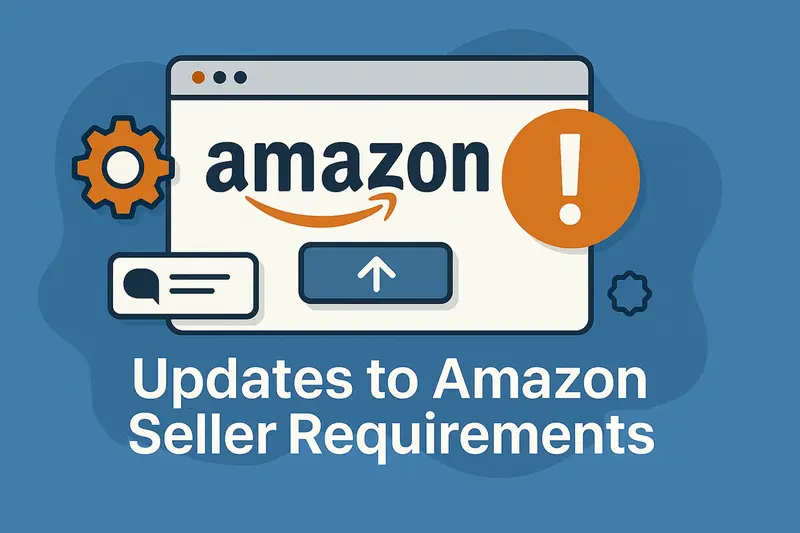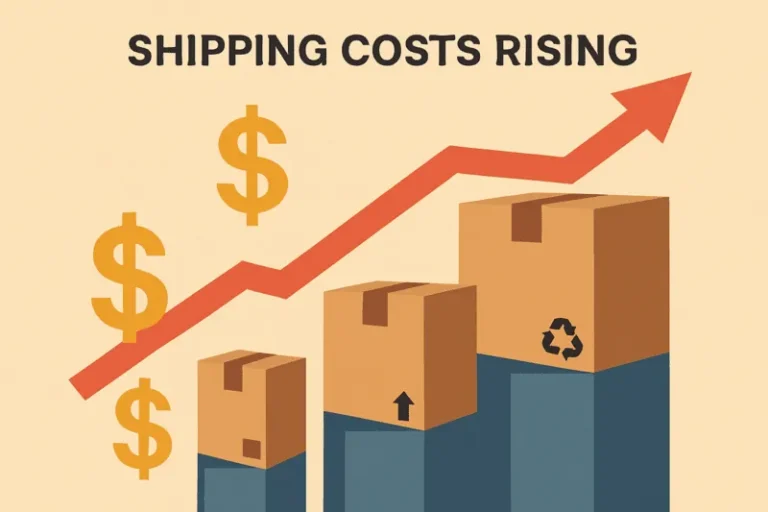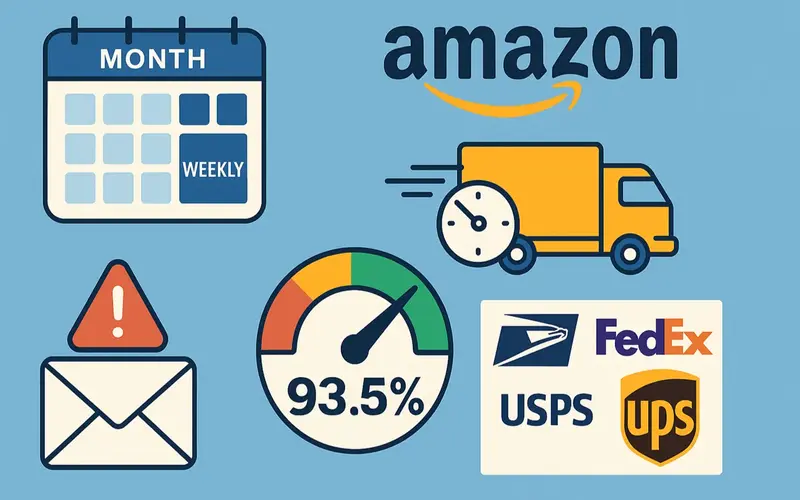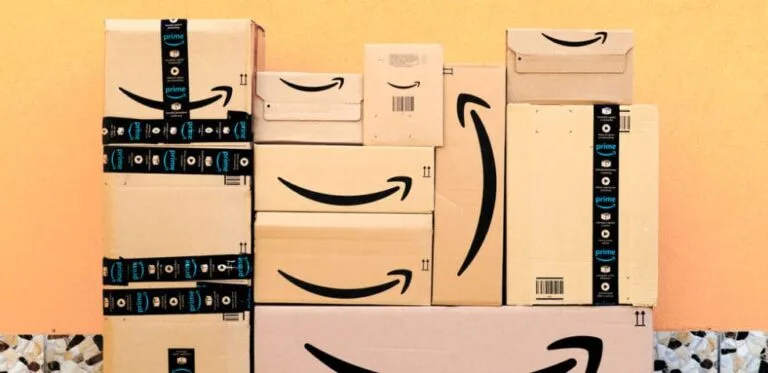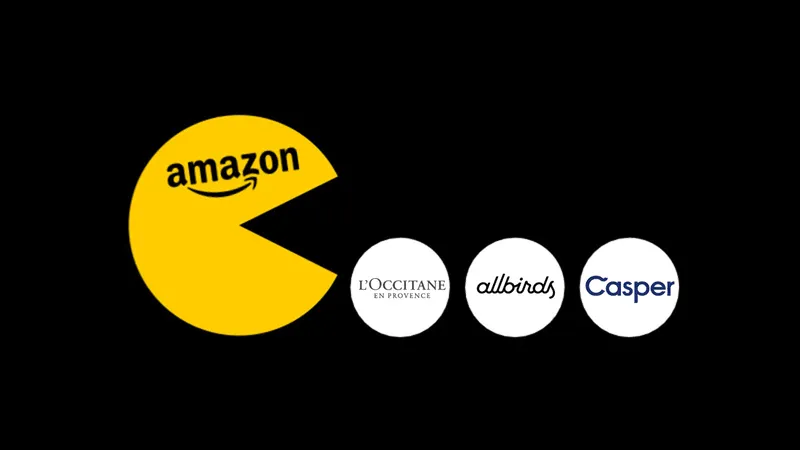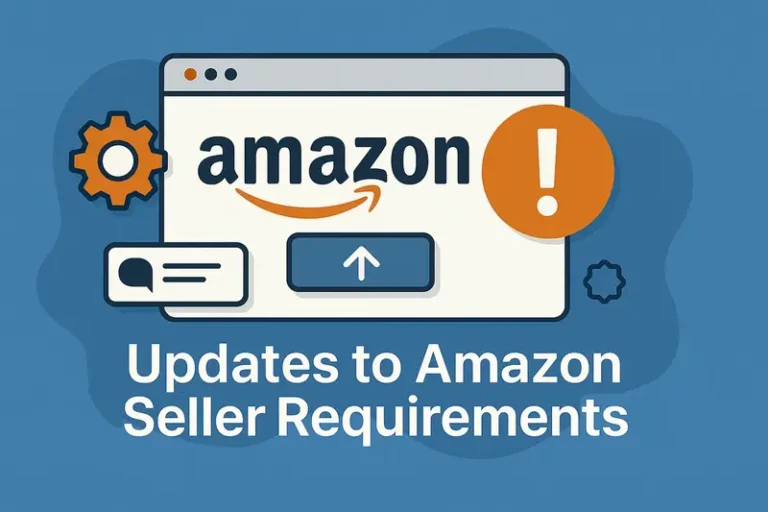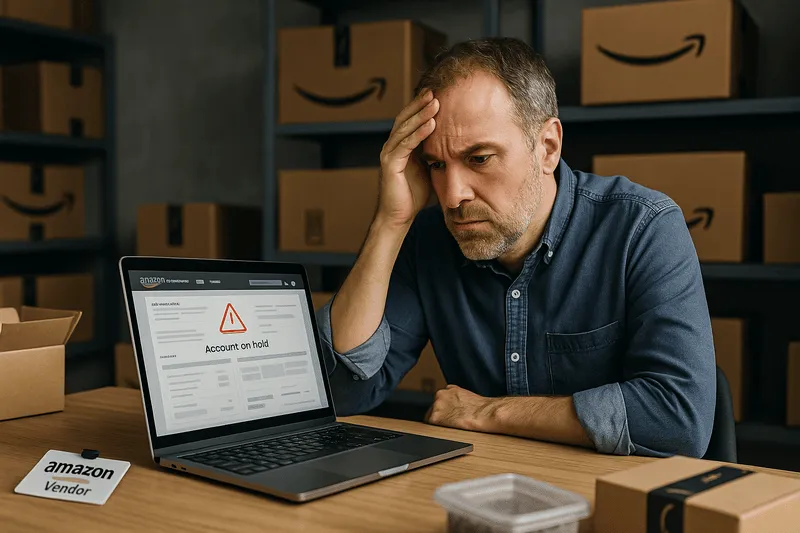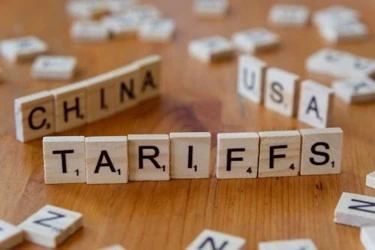Cahoot vs Veeqo: A Value-Driven Comparison for Modern Ecommerce Sellers
In this article
 9 minutes
9 minutes
- At a Glance: Cahoot vs Veeqo
- Pricing Models & Carrier Rates
- Order Routing & Workflow Automation
- Multi-Channel Capabilities
- Inventory & Warehouse Management
- Support & Learning Curve
- Amazon Buy Shipping & SFP
- Data You Can Actually Use
- Built for Amazon Sellers, but Not Owned by Amazon
- Pros & Cons
- Cahoot vs. Veeqo: What Sellers Are Saying
- Final Verdict
- Frequently Asked Questions
When ecommerce sellers start scaling across marketplaces like Amazon, eBay, Walmart, and Shopify, their shipping software can either accelerate that growth or slow them down. Two platforms built to handle multi-channel shipping are Veeqo and Cahoot. Both offer discounted shipping labels and order management tools, but the similarities end there. This in-depth comparison will explore what each software delivers, what it lacks, and which one ultimately supports fast-moving ecommerce teams better.
At a Glance: Cahoot vs Veeqo
|
Feature
|
Cahoot
|
Veeqo
|
|---|---|---|
|
Multi-Channel Order Import
|
Yes
|
Yes
|
|
Discounted Carrier Rates
|
Yes
|
Yes
|
|
Rate Shopping Across Carriers
|
Yes
(Autonomous) |
Yes
(Basic) |
|
Bulk Label Printing
|
Yes
(Autonomous) |
Yes
(Traditional) |
|
Support for Own Carrier Accounts
|
Yes
|
Yes
|
|
Automation Rules & Order Routing
|
Yes
(Highly Configurable) |
Limited to Presets
|
|
Intelligent Package Selection (Cartonization)
|
Yes (AI-powered)
|
No
|
|
WMS Features
|
Yes
|
Partial
|
|
Inventory Visibility
|
Yes
(real-time) |
Yes
(limited granularity) |
|
Returns Workflow Integration
|
Optional Peer-to-Peer Returns
|
Basic RMA
|
|
Live Customer Support
|
Yes
(Help Desk, Phone) |
No phone support
|
|
Amazon Buy Shipping API Certified
|
Yes
|
Yes
|
|
Supports Amazon SFP
|
Yes
|
No
|
|
Open to 3PLs
|
Yes
|
No
|
Pricing Models & Carrier Rates
Both Cahoot and Veeqo offer access to discounted shipping rates from major carriers like UPS, FedEx, and USPS. Veeqo highlights its access to Amazon-negotiated carrier rates, especially beneficial for FBM sellers. However, it’s worth noting that Cahoot also offers deeply discounted rates through its aggregated carrier network, and unlike Veeqo, sellers aren’t required to be Amazon merchants to access them.
Users have praised Veeqo’s rates in particular, though some feel that the real-world savings depend on volume and location. One user on Trustpilot noted, “Veeqo offers good rates, but it doesn’t always beat what I negotiated directly with FedEx.” That said, having an option for both Veeqo and using your own account provides flexibility.
Cahoot lets sellers compare real-time rates across carriers, or even better: automate all the rate shipping and bulk shipping label generation based on the desired logic (cheapest, fastest, delivery promise, signature-required, etc.). This level of autonomous support (removing the human) goes a step further than Veeqo’s more manual workflows.
Order Routing & Workflow Automation
This is where the gap between the two platforms widens. Cahoot excels at automation.
Cahoot’s rule engine lets sellers automatically assign orders to specific warehouses, select packaging based on product dimensions, and pick carriers based on dynamic rules. It includes AI-powered cartonization, reducing overpackaging and optimizing label selection at scale. This feature alone can save high-volume shippers thousands per month.
Veeqo supports some automation, but according to multiple reviews, the rules engine lacks flexibility. As one user put it: “You can automate some parts of the shipping process, but complex routing logic just isn’t possible.” Another noted on G2, “Our warehouse team constantly has to manually override presets in Veeqo to get the right shipping option.”
Cahoot also offers the option to import product master data, assign SKUs to multiple warehouses, and automate routing for distributed fulfillment. These features are especially helpful for sellers managing multiple sales channels and warehouse locations.
Multi-Channel Capabilities
Both platforms support multi-channel order import from Amazon, eBay, Shopify, Walmart, Etsy, and more. Veeqo is tightly integrated with Amazon (it’s owned by Amazon), which brings advantages for FBM sellers, like access to Buy Shipping and automated order syncing.
However, some sellers note that Veeqo prioritizes Amazon workflows and that the support for non-Amazon channels lacks depth. A Trustpilot reviewer stated, “It’s clearly built with Amazon in mind. Shopify orders don’t always sync correctly, and the custom mapping is limited.”
Cahoot offers native integrations with all major ecommerce platforms, with equal priority across sales channels. That neutrality is useful for brands expanding beyond Amazon and looking to centralize operations across multiple storefronts.
It also means Cahoot isn’t limited by Amazon policy shifts or ecosystem changes. For businesses hoping to grow a multi-platform brand, that independence matters.
Inventory & Warehouse Management
Veeqo includes basic inventory tracking tools but doesn’t offer a full warehouse management system (WMS). Its UI shows available stock and syncs between platforms, but lacks pick/pack workflows, barcode scanning, and location-based inventory management.
Cahoot includes WMS features as part of the platform, with no need for third-party plugins. Sellers can assign bin locations, manage cycle counts, and generate pick lists automatically. One Cahoot user shared, “We reduced picking errors by 60% after switching from ShipStation to Cahoot because the WMS features are built in.”
For growing brands with even modest warehouse operations, this difference is key. It consolidates tech stack complexity and reduces reliance on disconnected tools.
Support & Learning Curve
Cahoot provides live onboarding, in-platform chat, and phone support. Multiple users note how responsive the support team is. One review on G2 says, “Every time I had an issue, Cahoot got back to me within minutes. I never felt like I was waiting around.”
Veeqo, on the other hand, has no phone support, and several users on Trustpilot and Reddit cite frustrating support delays. One review read, “You submit a ticket and wait… sometimes for days. It’s not great when your entire shipping flow is paused.”
Veeqo also has a steeper learning curve for non-Amazon users. The dashboard is robust but not intuitive for sellers focused on Shopify or direct-to-consumer models.
Amazon Buy Shipping & SFP
Both platforms are certified for Amazon Buy Shipping, meaning they help sellers remain compliant with Amazon’s policies and tracking requirements. However, only Cahoot supports Seller Fulfilled Prime (SFP).
For Amazon SFP sellers, this is a major differentiator. Cahoot’s compliance engine ensures same-day label printing, cut-off time enforcement, and late-delivery prevention. Veeqo does not support this, which rules it out for many brands trying to maintain the Prime badge.
Data You Can Actually Use
With Veeqo, many sellers are flying blind. Sales data is fragmented. Shipping costs aren’t always transparent. And pulling that data often means wrangling spreadsheets with missing headers or running into failed exports.
Cahoot makes it easy to analyze profits, understand shipping costs, and track eligible shipments in one dashboard. You get full access to real performance data without needing to bounce between platforms.
Built for Amazon Sellers, but Not Owned by Amazon
Veeqo is owned by Amazon. That means anything you do on the Amazon platform is potentially visible. For Amazon sellers trying to protect their strategy or operate across other channels, that’s a problem.
Cahoot is fully compatible with Amazon FBM, FBA, and Buy Shipping, but stays independent. You get the lowest rates available, without locking yourself in deeper with Amazon or giving up your leverage.
Pros & Cons
Cahoot vs. Veeqo: What Sellers Are Saying
“Using Veeqo costed us so much time. Exports kept failing, inventory didn’t match, and the UI was just confusing. Cahoot gave us back control.”
~ Multichannel seller, apparel industry
Speak to a fulfillment expert
“The only reason I stuck with Veeqo was because it was free. But once our shipping volume increased, we needed more, and Cahoot delivered.”
~ Electronics brand owner
Speak to a fulfillment expert
Final Verdict
Veeqo is a solid, free tool for Amazon-first sellers who want to print shipping labels and access decent rates with minimal setup. But it lacks depth in automation, support, and warehouse operations.
Cahoot, by contrast, is built for scale. It’s ideal for ecommerce brands that are serious about operational efficiency and growth. From smart automation to robust warehouse tools and superior customer support, Cahoot is the better long-term investment for sellers looking to streamline operations across multiple platforms.
If you’re running a high-volume ecommerce business that ships across multiple sales channels, handles inventory in multiple locations, or simply wants to reduce costs and errors at scale, Cahoot is the clear winner.
Don’t settle for free if it slows your business down.
Choose smarter. Explore how Cahoot can simplify your shipping and scale with your brand.
Frequently Asked Questions
Is Veeqo really free, and what’s the catch?
Yes, Veeqo is technically free, but many sellers report that key features like bulk shipping, inventory management, and reporting are limited. You may still need your own carrier accounts, and support can be slow.
How does Cahoot’s shipping software help reduce shipping costs?
Cahoot gives sellers access to discounted rates across major carriers like UPS, FedEx, and USPS, with no Veeqo credits or software bugs required. Plus, bulk shipping tools and data-driven insights help optimize your entire shipping process.
Can I use Cahoot if I sell on Amazon and other ecommerce channels?
Absolutely. Cahoot supports multiple sales channels, including Amazon, Walmart, eBay, and Shopify, while keeping inventory levels synced across all platforms. Unlike Veeqo’s integration, Cahoot’s system is fast, clean, and flexible.
What makes Cahoot better for inventory management than Veeqo?
Cahoot simplifies multi-channel inventory with real-time stock tracking, automated syncing, and alerts to prevent overselling. Veeqo users often struggle with managing inventory across platforms due to sync lags and poor data visibility.
Why do sellers leave Veeqo for Cahoot?
Many sellers switch when they realize Veeqo’s free model comes with trade-offs: limited support, Amazon ownership, clunky UI, and frustrating data export issues. Cahoot offers a full-featured, seller-first solution that saves time and drives smarter decisions.

Turn Returns Into New Revenue

Amazon Limits How Sellers Can Message Buyers
In this article
 3 minutes
3 minutes
Amazon’s Buyer-Seller Messaging tool lets you reach out to customers when there’s a hiccup with an order or when they have questions: think missing details, address clarifications, or service follow-ups. It’s never been a billboard for promos or marketing; it’s strictly a support channel. Starting now, Amazon is tightening things up even further to protect buyer preferences and ensure you only send messages that truly matter.
How It Worked Before
Until recently, you could mark a subject line with “[Important]” to push your message past a buyer’s opt-out settings. In other words, even if a buyer said, “No thanks, I don’t want seller emails,” you could override that if you slapped “[Important]” on the subject. Amazon trusted sellers to use that sparingly, only for truly critical updates like “Your customized widget is delayed” or “Need help with your order return.” But, let’s be honest, there was room for misuse (even if accidental).
The New Changes
Amazon has removed the ability to add “[Important]” and override buyer opt-outs. If a buyer has opted out of seller communications, your message won’t get through, unless it’s genuinely critical to completing the order. In practice, that means:
- No More Subject-Line Overrides: You can’t flag any message as “[Important]” manually.
- Opt-Out Respect: If a buyer has chosen not to receive non-essential messages, your message gets blocked, unless it’s a truly order-critical update.
- Critical Messages Still Go Through: If you’re contacting someone to confirm a custom size, fix a shipping address, or resolve a payment hiccup, Amazon will deliver your message even if the buyer opted out.
What Sellers Should Do Next
- Rethink Your Subject Lines
- Don’t worry about manually tagging “[Important]” anymore; Amazon handles critical identification on its end. Keep your subject lines clear and concise—“Issue with Your Order #123-4567890” is fine.
- Use Amazon’s Message Templates
- These templates auto-insert the order ID, translate into the buyer’s language of preference, and automatically flag truly critical content. They’re a time-saver and help ensure Amazon recognizes your message as essential.
- Focus on Truly Critical Communication
- Ask yourself: “Is this message truly necessary to complete the order?” If you need to verify a shipping address, correct a payment method, or address an out-of-stock situation, go ahead. If it’s a follow-up—“Hey! Buy my new product!”—save it for social media or your own email newsletter.
- Stay Organized & Document Everything
- Because Amazon now filters more messages, keep detailed records of when and why you contacted buyers. If a buyer reaches out later asking why they didn’t get your message, you’ll know exactly what happened.
Why These Changes Matter
At the end of the day, Amazon is aiming to keep buyer inboxes free of clutter. You want your truly essential messages (like “Your order requires more info” or “Your refund is processed”) to land easily in your buyer’s inbox, not buried under promotional noise. By removing the “[Important]” override, Amazon ensures that only messages genuinely vital to order completion break through.
For sellers, it’s a quick pivot: lean into Amazon’s templates, keep communication laser-focused on order fulfillment, and respect buyer opt-outs. That way, you maintain trust, avoid blocked messages, and keep your operations running smoothly, one critical message at a time.

Turn Returns Into New Revenue

New 2025 Amazon Premium Shipping Requirements
Amazon’s Premium Shipping program has always driven better conversion rates, improved Buy Box share, and happier customers. But come June 29, 2025, Amazon is rolling out sweeping changes to Premium Shipping performance requirements, and they’re not kidding around. If you’re an ecommerce pro, brand operator, logistics expert, or retail strategist, buckle up. Here’s everything you need to know, served in a conversational style, with a dash of candor, and a sprinkle of “keep-your-cool” honesty.
From Monthly Roll-Ups to Weekly Check-Ins
Let’s cut to the chase: under the old system, you needed a 97% on-time delivery rate (OTDR) over a rolling 30-day window to keep that Premium Shipping eligibility. Amazon looked at your performance once a month, sent one warning if OTDR dipped below 97%, and gave you until the next month to fix it. Easy enough—if you had a random bad week, you could smooth it out with stellar performance the rest of the month.
Starting June 29, though, those monthly buffers disappear. Amazon will track OTDR on a weekly basis, from Sunday through Saturday, and drop any Seller Fulfilled Prime (SFP) orders from that calculation. If your OTDR for Premium Shipping falls below the new minimum, 93.5%, you’ll get your first email warning. Do it again next week, and you’ll receive a second warning. Miss the same threshold three times within four consecutive weeks, and you’re out of Premium Shipping until you earn it back.
Why 93.5%? Amazon’s rationale is that they want customers to experience the same reliability they’ve come to expect from the Prime program. Dropping the requirement from 97% to 93.5% might seem like a concession, but trust me, hitting 93.5% every single week is not easy when you’re dealing with carriers that are out of your direct control.
Why This Matters (and Why It’s Tougher Than It Sounds)
No More “Average” Weeks
Under the old model, you could have one sloppy week at, say, 94%, and then three spectacular weeks at 99%, and your overall 30-day OTDR would still be above 97%. Now, if that first week is below 93.5%, you’ll get dinged immediately. A single underperforming week can trigger a warning, and you can’t “erase” it with future weeks once that four-week window closes.
Carriers Need to Be in Your Back Pocket
Amazon explicitly calls out approved carriers like UPS, FedEx, USPS, and OnTrac. If a carrier misses scans, delays pickups, or delivers late, you’re on the hook. The OTDR calculation counts the percentage of orders that arrived on or before the promised “Deliver by” date. If your package is scanned late, or not scanned at all, Amazon assumes it’s going to be late unless an on-time delivery scan is received later. That’s why it’s more important than ever to monitor each carrier’s performance, review their “Last-Mile Delivery” scorecards, and swap out underperformers.
Shipping Settings Automation & OTDR-Protected Labels
Good news: Amazon is offering tools to help you hit your weekly targets. Shipping Settings Automation (SSA) will calculate transit times automatically so your “Deliver by” promises match real-world carrier performance. You still need to set accurate handling times, but SSA can help avoid accidentally over-promising.
Then there’s OTDR protection: if you enable SSA and purchase an OTDR-Protected label through Amazon Buy Shipping, Amazon won’t penalize you for late deliveries as long as the delay is due to factors outside your control. It’s essentially a safety net—except it only applies if you do everything else right (set your handling time properly, buy the right label, and ship on time).
What Sellers Must Do Right Now
1. Audit Your Carriers
- Pull up your Carrier Scorecard in Seller Central each Monday morning.
- Look for patterns: Who’s got the slowest last-mile scans?
- Drop carriers that regularly clock in under 95% weekly on-time scans, because once you hit 93.5%, there’s zero wiggle room.
2. Enable SSA on Every Shipping Template
- Navigate to Shipping Settings → Edit Template → Toggle on Shipping Settings Automation.
- Let Amazon calculate transit times based on carrier data. If you don’t do this, you’re basically flying blind and promising delivery dates you can’t reliably meet.
3. Purchase OTDR-Protected Labels
- Go to Manage Orders → Buy Shipping and look for the shield icon indicating “OTDR Protected.”
- If you use an external tool like Cahoot, make sure it’s integrated and configured to buy the correct labels.
4. Track Your OTDR Like a Hawk
- Check your Account Health → Shipping Performance → On-Time Delivery Rate view, filtered to the “Last 7 Days.”
- Log it in a simple spreadsheet or dashboard; if you’re at 95% on Thursday but have a big FedEx hiccup on Friday, you might dip under 93.5% by Saturday.
5. Prepare an Appeal Template
- If you get that dreaded second warning email, you have two weeks to appeal.
- Your appeal should include:
- Specific orders that caused the miss (order IDs, promised vs. actual dates).
- Evidence that you used SSA and OTDR-Protected labels (screenshots help).
- Steps you’re taking to prevent a repeat (e.g., switching carriers, adjusting handling times).
The Ripple Effects on Your Business
Margin Compression vs. Service Reliability
Yes, spending more on premium carriers or buying OTDR-protected labels adds cost. But losing Premium Shipping can crater your conversion rate, tank your Buy Box percentage, and even affect organic search ranking. You have to run the numbers: maybe offering fewer SKUs with Premium Shipping is cheaper in the long run than risking weekly OTDR failures that affect your sales on your highest-performing SKUs (by being kicked out of the program).
Operations & Inventory Juggling Acts
Keeping enough stock in the “right” warehouses, so carriers aren’t shipping from the opposite coast, matters more than ever. If you sell nationally, you may need multiple fulfillment locations (a 3PL or micro-fulfillment center network). Staggering your replenishment orders (especially around holidays) can prevent stockouts that force you to oversell and then ship late.
Small Sellers vs. Big Sellers
Large brands with multi-warehouse setups and teams dedicated to carrier management can adjust more fluidly. If you’re a one-person operation fulfilling out of your garage, you’ll need to be extra strategic—maybe select just two to three proven carriers and ship as many orders as possible the same day you pick them. The bar is higher now, and patience for shipping errors is slim.
A Few FAQs to Keep You Sane
Q: What happens if a hurricane or blizzard slows down my carrier?
A: If Amazon deems it a “major disruption event,” late deliveries in that region won’t count against your OTDR. But you still need SSA + OTDR-protected labels before the delay. Don’t wait for your messages to start flooding; enable those tools now.
Q: Will this affect Seller Fulfilled Prime?
A: Sort of. SFP has its own stricter OTDR requirements, also on a weekly cadence, but it’s evaluated separately. Just remember, your SFP and Premium Shipping OTDRs are on parallel tracks; a slip in one doesn’t automatically tank the other, but it’s best to nail both.
Q: Can I regain Premium Shipping status after removal?
A: Yes, but you must meet all OTDR requirements for four consecutive weeks after your third infraction (without another miss). It’s basically a “clean slate” window: stay above 93.5% each week for four weeks, and Amazon resets your eligibility for that specific requirement.
Final Thoughts: Embrace the Change (or Get Left Behind)
Amazon’s shift from a 30-day OTDR roll-up to a 7-day weekly check is a clear message: if you want to hang with Prime-level sellers, you need rock-solid operational consistency and carrier partnerships. There’s no “coasting” on the back of a stellar month anymore; you have to nail every single week.
Yes, the change feels daunting. Your margins may squeeze, and your team (even if it’s a team of one) will need to revamp processes. But savvy ecommerce pros know adversity breeds opportunity. Rethink your shipping playbook:
- Lean into SSA and OTDR-protected labels.
- Cultivate trusted carrier relationships (and ditch underperformers ASAP).
- Monitor your weekly OTDR like your P&L depends on it (spoiler: it does).
- Build redundancy, FBA hybrid, multi-warehouse, or strategic 3PL partnerships.
Master these moves, and you won’t merely survive—you’ll thrive. Happy selling, and may your weekly OTDR always stay north of 93.5%.
Citations
- Amazon Seller Central – Upcoming changes to Premium Shipping
- Amazon Seller Central – Frequently asked questions about on-time delivery rate (OTDR)

Turn Returns Into New Revenue

Fewer Sellers, Bigger Gains: Seizing Amazon’s Shrinking Competition in 2025
Amazon used to feel like a never-ending battlefield: millions of sellers duking it out for every eyeball. Fast-forward to 2025, and things have quietly shifted. Yes, a ton of new sellers keep signing up—roughly a million a year—but the number of active sellers (those getting at least one review in the past year) has actually fallen from about 2.4 million in 2021 to under 1.9 million in 2025. That’s a 20% drop, and it means there’s more traffic up for grabs per seller. In plain English, the average Amazon seller now gets nearly 31% more visits than four years ago. Cue the confetti for anyone still standing, and some serious sticker shock for those just starting out.
Why the Dip in Active Sellers Matters
Let’s unpack that number: Amazon’s overall traffic has stayed roughly level since 2021, clocking in at around 5 billion visits per month across its global network. But active sellers declined from 2.4 million to 1.9 million between 2021 and 2025. Divide the same or slightly higher traffic by fewer storefronts, and voilà, monthly visits per seller climbed from 2,162 to 2,837. In other words, if you’re still in the game, you’ve got about 31% more potential buyer eyeballs on your listings than your counterparts did a few years back.
That traffic bump isn’t just academic. With Amazon’s revenue surging 36% (from $470 billion in 2021 to $638 billion in 2024), it’s clear the pie is growing even as some sellers fall out. Third‐party sellers, who already sold 56% of units in Q4 2021, pushed their share up to 62% by Q4 2024. Translation: More of a bigger pie is yours for the taking if you can navigate the challenges.
Why Sellers Are Fading Out
Okay, so why are fewer “active sellers” sticking around? A few big reasons: rising fees, logistical headaches, and cutthroat price wars.
- Amazon’s Fees Have Ballooned
- In some categories, referral, FBA pick‐and‐pack, and storage fees now gobble up over 50% of a product’s list price.
- Monthly or seasonal storage surcharges and random “reclassification fees” can make it feel like Amazon’s charging you just for breathing.
- The result? Margin erosion that many newcomers can’t stomach.
- Inventory & Case-Management Headaches
- FBA is a blessing until your inventory gets stranded, buried under storage‐fee surcharges, or stuck in removal limbo. Solving these requires hours of back-and-forth with Seller Support.
- Switching to FBM (Fulfilled by Merchant) isn’t a slam dunk either; sourcing reliable carriers, managing returns, and weathering holiday shipping bottlenecks add a new layer of complexity.
- Regulatory & Tariff Unknowns
- Tariff rates have been fluctuating unpredictably, particularly for goods from China or certain apparel categories. A 10% hike overnight can wreck your COGS (cost of goods sold) if you’re unprepared.
- Sales tax laws and cross-border customs rules shift every few quarters. Small sellers risk penalties if they slip up.
- Chinese Seller Dominance
- Chinese merchants make up over half of the top-performing Amazon accounts, often undercutting U.S. sellers with razor-thin margins. It’s tough to compete on price when factory-direct sellers list at rock-bottom rates.
Put those together, and it explains why many hopeful sellers register, list a few products… and then disappear. In fact, more than 60% of the top 10,000 Amazon sellers launched before 2019, proving that experience and staying power are huge advantages.
Why the U.S. Marketplace Still Reigns Supreme
If you’re deciding where to list, the U.S. marketplace is still the gold standard. Sure, places like Saudi Arabia boast 8,228 visits per seller, and South Africa is close behind at 8,065. But those markets simply don’t have the total volume or category breadth of Amazon.com. In the U.S., a niche term like “sourdough starter jar” gets roughly 26,766 monthly searches, compared to 179 in Australia or zero in Saudi Arabia. In other words, niches thrive stateside in a way they can’t elsewhere.
Even better: 73% of U.S. sellers who joined in the past year hit their first sale within 12 months. That’s substantially higher than Germany (38%), the U.K. (32%), or Canada (16%). For new sellers looking for quick validation, the U.S. simply offers the best odds.
Challenges to Confront Head-On
More traffic is great, but it doesn’t magically overcome the hurdles. Here’s what you’ll face if you jump into Amazon today:
- Margin Erosion: Even with extra visits, if your fees and COGS leave you with negligible profit per unit, those extra eyeballs won’t matter. Carve out a robust pricing model, know your true landed cost—including tariffs, shipping, Amazon fees, and PPC.
- Inventory Planning: Sell-through rates matter. Overstocking triggers costly storage fees; understocking loses you the Buy Box and lets competitors swoop in. Sophisticated 3PL integrations or tools like Forecastly can help you thread the needle.
- Competitive Pricing & Buy Box Battles: Repricers can help, but they’re not magic. When Chinese sellers aggressively undercut, you risk starting a race to the bottom. Focus on unique value propositions, bundling, subscription offers, or enhanced branding to stand out.
- Regulatory Compliance: Keep up with tariff updates. For instance, electronics gear imported from Asia might incur new duties under a 2025 trade ruling—know it before it blindsides your margin.
- Account Health Vigilance: A single A-to-Z claim or policy violation can drop your seller rating. If you rely on Amazon for 80% of your sales, a suspension can be devastating. Build redundancies: own a Shopify store or diversify into Walmart Marketplace.
How to Capture Your Piece of the (Growing) Pie
1. Lean Into Niche Categories: If you’re selling something ultra-specialized—think artisan beard balm, eco-friendly pet toys, or limited-edition kitchen gadgets—your “competition” pool is smaller. Use tools like Helium 10 to spot emerging micro-niches before they catch fire.
2. Optimize Listings with SEO & Enhanced Content: Keywords matter, but so does conversion. High-res images, 360-degree product videos, and A+ content can take your listing from meh to must-buy. When you’ve got 30% more visits, conversion-rate improvement is pure gold.
3. Strategic PPC & DSP Budgets: With that extra traffic cushion, you might discover that CPCs (cost per click) in your niche are actually lower now due to lighter competition. Run a lean Sponsored Products campaign; if your listing’s solid, you can turn that paid traffic into organic momentum.
4. Leverage Prime & Subscription Models: Products eligible for Prime enjoy a higher click-through rate. If the margin allows, consider bundling or small subscription programs to lock in recurring revenue rather than one-off purchases.
5. Diversify Fulfillment Options: FBA is convenient, but a 3PL (third-party logistics company) hybrid or FBM can be more cost-effective once you hit a certain volume. Free two-day shipping is table stakes; just make sure your margins survive the shipping fees.
6. Plan for International Growth, But Don’t Rush: The data shows 69% of sellers stay confined to one marketplace. If you nail the U.S., expanding later to Canada or Mexico can be a logical next step. But don’t spread inventory too thin across 22+ marketplaces when your U.S. business still has growth levers to pull.
The Road Ahead
As Amazon’s marketplace matures, the landscape will keep shifting—new fees might pop up, algorithm tweaks could rearrange SERP rankings, and global trade winds will bring fresh tariff puzzles. But right now, a rare alignment exists: fewer active sellers, steady or growing buyer traffic, and a rising slice of third-party volume. For brands with grit, this means more opportunity if you’re willing to do the heavy lifting.
The parting advice? Amazon’s game has always been about endurance. Weather the headwinds, optimize your listings, master your costs, and don’t be afraid to lean into niche categories—and you might just ride this 30% traffic bump into the kind of scale that felt impossible a few years ago.
Is it crowded? Sure. Is it still worth it? For those who can adapt, absolutely.
Citations
- Marketplace Pulse: Amazon Is Less Competitive Than Four Years Ago
- Marketplace Pulse: U.S. Is Amazon’s Most Beginner-Friendly Marketplace
- Marketplace Pulse: 69% of Amazon Sellers Sell in Just One Marketplace

Turn Returns Into New Revenue

The Ultimate Guide to Selling and Winning on Amazon Seller Fulfilled Prime
In this article
 31 minutes
31 minutes
- What is Seller Fulfilled Prime?
- SFP – Now More Relevant For Sellers Than Ever Before
- Diversify Beyond FBA
- Seller Fulfilled Prime – An Essential Tool for Ecommerce Growth
- The Competitive Advantages of Seller Fulfilled Prime
- Succeeding at SFP is Hard – Here’s Why
- The Cheat Sheet for Winning at Seller Fulfilled Prime
- Frequently Asked Questions
Watch On-Demand Webinar:
Amazon SFP – How To Sell and Win
In June 2023, Amazon announced they would reopen enrollment for their Seller Fulfilled Prime (SFP) program. Like most things in the Amazon world, the news was received with mixed reactions by Sellers. For those familiar with the Amazon ecosystem, they know that this program is challenging. Many feel the list of requirements is daunting and that Amazon holds them to higher standards than the ones it sets for its in-house Fulfilled By Amazon (FBA) logistics network.
Most people are familiar with the requirements that Amazon expects Sellers to meet, but far fewer are aware of the roadblocks that make success hard to achieve. An even smaller number are aware of the strategies they can deploy to meet Amazon’s criteria and surpass them. We’ve outlined all of that and more in our Ultimate Guide:
- We start by helping you understand what the program actually is and its benefits.
- Despite the daunting SFP requirements, the reward can be immense – we highlight the value that success in the program can deliver to your business.
- However, SFP success is not easy, and many Sellers find the program extremely challenging – we do a deep dive into the most common stumbling blocks that trip up even experienced Amazon merchants.
- Finally, we give you an essential cheat sheet needed to start selling and winning on Amazon Seller Fulfilled Prime!
One critical aspect to consider is the Seller Fulfilled Prime cost. Understanding the financial implications, including the program fee per item sold, percentage fees, and minimum fees, is essential for assessing potential profitability and managing profit margins effectively.
What is Seller Fulfilled Prime?
Before we do a deep dive, it’s essential to understand – what is the Seller Fulfilled Prime program?
Definition and Benefits of Seller Fulfilled Prime
Seller Fulfilled Prime (SFP) is a program offered by Amazon that allows third-party Sellers to display the Prime badge on their listings while maintaining control over their fulfillment process. This means sellers can ship Prime orders directly to customers within two days, ensuring fast and reliable delivery. By participating in SFP, sellers can significantly boost their visibility, credibility, and sales potential, all while providing an enhanced customer experience.
The benefits of SFP include:
- Increased Visibility and Credibility: Listings with the Prime badge are more likely to be seen and trusted by customers.
- Greater Control: Sellers have more options and control over their fulfillment process and inventory management compared to using Fulfilled by Amazon (FBA).
- Brand Building: Sellers can build their brand, including flexibility to provide unique experiences for customers, such as custom packaging, while maintaining Prime status.
- Increased Sales and Profits: The Prime badge can lead to higher sales and better profit margins.
- Amazon’s Customer Service: Access to Amazon’s customer service and support for handling customer service inquiries, but the ability to own customer service if desired.
- Lower Fees: Freedom from the high fees associated with Amazon FBA.
- Improved Support for Challenging SKUs: The ability to meet the consumer expectation for free and fast shipping even on slow-moving, seasonal, larger-sized, and heavier SKUs.
While all these are great, the biggest one for any Seller is that the program allows your product listings on the Amazon Marketplace to feature the coveted Prime badge. With over 180 million subscribers in the United States in 2025, Amazon’s loyalty program has a great promise for the end customer – pay $139 (plus taxes) annually, and Amazon will deliver you stuff for free in under two days.
The program has far more profound implications for Sellers – their ranking on Amazon search results and ability to win the “Buy Box” is heavily and positively influenced by ensuring their products are Prime eligible. It’s also no secret that most shoppers on Amazon toggle the filter when browsing the store just to see products that qualify for Prime. All this means that an Amazon merchant’s survival, let alone success, largely depends on ensuring each SKU is Prime-eligible.
Seller Fulfilled Prime offers Sellers the best of both worlds – the Prime badge and autonomy over order fulfillment. However, it isn’t all smooth sailing, and Sellers have tended to shy away from the program because of its exacting standards. However, there are indications that the present time is a good one to begin seriously considering enrolling in the program.
“Cahoot has amazing technology in addition to their large warehouse network, sort of like FBA but without the hefty fees or restrictions. Cahoot saved our peak-selling season!”
~ Joel Frankel, Fames Chocolates
Speak to a fulfillment expert
How Seller Fulfilled Prime Works
To participate in SFP, sellers must meet Amazon’s stringent performance requirements. These include:
- Own Warehouse: Sellers must have their own warehouse, (or partner with a robust and capable modern 3PL), and an Amazon Professional Seller account.
- Premium Shipping Options: Offering premium shipping options to customers.
- Exceptional Performance Metrics: Consistently exceeds for the On-Time Delivery, Valid Tracking, and Delivery Speed metrics while maintaining a very low Order Cancellation Rate.
- Supported Carriers: Delivering orders with Amazon’s approved Seller Fulfilled Prime carriers.
- Amazon Returns Policy: Agreeing to the Amazon Returns Policy.
Sellers must also complete a trial period, during which they must fulfill at least 100 Prime packages while adhering to all of Amazon’s strict shipping requirements. Once the trial period is successfully completed, the Prime badge will be displayed on their listings, granting access to Prime customers. More on this later.
SFP – Now More Relevant For Sellers Than Ever Before
Several reasons have combined to make Seller Fulfilled Prime more relevant than ever before for Sellers, some of Amazon’s own making along with others that are not as palatable to the company:
The “Prime Effect”: Everybody Wants Fast Shipping
When Amazon first introduced Prime in 2005, it announced that it would ship customer orders over $35 for free in 2 days. At the time, people in the industry thought that the company had lost its mind and that this strategy would surely fail. It took competitors over a decade to offer free 2-day shipping – retailers like eBay and Walmart introduced their competing services only in 2017.
However, when Prime moved from its 2-day timeline to free 1-day shipping in 2019, Walmart and BestBuy responded almost immediately, offering customers the same experience. That captures just how much Amazon has raised the bar and redefined customer expectations – the Prime effect means that all of us expect everything delivered in under two days for free.
The stakes are high for ecommerce merchants across every channel – it does not matter whether you serve customers through a Shopify storefront, eBay, Amazon, or Walmart – you have to meet the consumer expectation for fast order fulfillment.
Shipping is no longer a back-office operation; it has become the defining element of the customer experience.
The company that created the Prime Effect is arguably the most customer-obsessed organization in the world. For years, Amazon has focused relentlessly on creating value for its customers – often at the expense of Sellers on its platforms. At every turn, the company has weaponized the size of its customer base and the network effects of its marketplace model to squeeze Sellers while delighting customers.
People, regulators, and governments aiming to call out the company on some of these practices have been met with a frequent refrain, “As long as the end customer is happy, how does it matter?” But why are customers so happy with Amazon, and how does the company have so many of them (most of whom are Prime members)? The most important reason is Amazon’s ability to ship products in under two days, nearly always on time.
“Cahoot allows us to offer 2-day shipping on our website in addition to driving more sales nationwide SFP on Amazon. This app saves us a ton of time and money every single day!”
~ OZ Medical
Speak to a fulfillment expert
Diversify Beyond FBA
For Sellers operating on Amazon, the approach has often been relatively straightforward: let Amazon FBA take care of it all and only use Fulfilled By Merchant (FBM) or SFP as a backup in the rare event of an emergency. However, given how FBA has repeatedly proven to quickly and substantially change program requirements and fees, a backup may no longer suffice – Sellers may need to devise an entirely new order fulfillment strategy.
Sellers Have Traditionally Relied on FBA
According to Jungle Scout, 64% of Amazon Sellers use FBA exclusively to deliver their orders, with only 14% choosing to completely cut ties with FBA and handle everything independently.
There are good reasons for this – the algorithm determining whether a product listing will win the Buy Box uses fast order fulfillment as a leading criterion. The fact that FBA listings are automatically Prime eligible is attractive for many Sellers (SFP listings also have a great chance to win the Buy Box, while merchant-fulfilled non-Prime orders trail well behind).
The well-known A10 algorithm, which ranks products in search results on Amazon, also prefers listings with fast order fulfillment, which has led Sellers to lean in heavily on FBA (again, a Seller Fulfilled Prime order can show up favorably, subject to the merchant doing other things right, such as optimizing for the right keywords in their product detail page copy).
The question Sellers might ask is: why would I do all the extra work required by SFP listings when it’s easier to win the buy box and rank well with FBA alone? To answer the question with a question: why not both? Not only do you get more shots on the Buy Box goal, but SFP listings typically sell for 15 – 20% more, plus increased discoverability and conversion compared to non-SFP FBM listings (82% of Sellers are offering both FBA and FBM versions of their listings).
So, why not all three? If you like FBA, continue to sell on FBA, but add SFP to your FBM listings and some will sell at the higher price and you’ve done nothing other than duplicate your listings. When the 180 Million Prime members apply the Prime-only filter when browsing for products on Amazon, they do it for no other reason than fast and free delivery. Will you be there to sell to them?
Seller Fulfilled Prime – An Essential Tool for Ecommerce Growth
Well, technically, you do have more to do than just duplicate your listings. You have to fulfill the orders with fast and free shipping, and you must meet the uncompromising performance metrics.
Seller Fulfilled Prime Requirements
- Maintain an On-Time Delivery Rate greater than 93.5% (A delivery is on time if it is delivered on or before the delivery date promised to the customer when they checkout).
- Maintain a Valid Tracking Rate (VTR) higher than 99% – a package has Valid Tracking if it has at least one carrier scan. This scan must occur before the package is delivered to ensure it provides a tracking number that can be used by the customer to track their order.
- Any product linked with a Prime shipping template must offer a minimum shipping speed of 3-5 days to the contiguous United States (the lower 48 states), across all 3 size tiers: Standard, Oversize, and Extra Large.
- Product detail page views must promise 1-day nationwide delivery to at least 30% of customers looking at Standard-size products, and 2-day nationwide delivery to at least 70% of page viewers of the same size tier. For Oversized products, these metrics are 10% and 45%, respectively. For Extra Large products, 15% of product detail page views must promise 2-day delivery (there is no 1-day expectation for these SKUs at this time). Note that Oversize and Extra Large SKUs may use regional shipping templates, so they are not required to deliver nationwide in 2 days or less.
- Merchants must first go through a pre-qualification process before starting their SFP trial. In the 90 days leading up to starting an SFP trial, they must self-fulfill at least 100 packages, with a Cancelation Rate <2.5%, Valid Tracking Rate >95% and Late Shipment Rate <4%. Once they are approved for the trial, they must ship at least 100 packages in 30 days while meeting all the SFP program requirements above.
- To fulfill Prime trial orders, Sellers should identify these orders within Seller Central by looking for the Prime badge and ‘IsPrime’ tag, which help in managing these specific orders efficiently.
- Sellers must provide free returns for all eligible items weighing less than 50 lb, for any reason.
- Amazon will not excuse late deliveries due to a carrier’s failure to deliver on time during the trial period (after passing the trial, they will). You must make sure that your order volume can incur a few late deliveries per trailing 7 days and still exceed the On-Time Delivery performance metric.
- During this entire period, the Prime badge will not be visible to customers on listings. After successful completion of the pre-qualification and trial period, Amazon will enable the Prime badge for your listings.
- You can request a 30-day SFP trial three (3) times per calendar year, and any trial overlapping the 30 days before major selling events such as Prime Day, Black Friday–Cyber Monday, or Christmas will be ineligible for graduation. Plan your trials in quieter months (e.g., January – February) to avoid wasted attempts.
- After graduating from the trial, you must fulfill a minimum 100 Prime-eligible packages each calendar month (evenly spread out) or face dynamic caps on your Prime order volume until you restore consistent output. It is not acceptable to ship 15 SFP orders in the first 3 weeks and then play catch-up in the last week; you will be throttled.
The critical thing to remember (which is the kick in the teeth for Sellers) is that Amazon FBA does not face any penalties for missing any of these performance metrics – whereas the onus is on the SFP merchant to diligently track these metrics and ensure you never fall below the minimums. To enable Prime shipping, Sellers must adjust their shipping templates and make specific selections in Seller Central to choose delivery regions for Prime service.
If this list appears daunting, you’re not alone – many Sellers feel these criteria are tough to meet. So before even looking at where the challenges and roadblocks lie, it’s worth asking – why is it worth being part of the program, and what value can it deliver to your business?
“Amazon SFP is such a demanding program, it is very difficult to find partners with the ability to pull this off. Cahoot is clearly geared towards Amazon Seller Fulfilled Prime, and excels at it via a network of strong fulfilment partners and a deeply knowledgeable team.”
~ Cali’s Books
Speak to a fulfillment expert
The Competitive Advantages of Seller Fulfilled Prime
While these are all great benefits for Sellers and provide their businesses with significant competitive advantages, making a success of the SFP program is highly challenging. Most merchants know that the requirements list is rigorous and demanding, but few are aware of the exact stumbling blocks that trip up people. Fewer are aware of solutions available to overcome these roadblocks and win at SFP.
Succeeding at SFP is Hard – Here’s Why
While the list of criteria is long and rigorous, we’ve identified the most challenging aspects of the program that trips up most Sellers:
Nationwide Fast Delivery Forces Most Sellers to Use Expensive Air Shipping
- In the past, Amazon had “regional Seller Fulfilled Prime” – which allowed Sellers to manage order fulfillment in certain geographical parts of the country while still having the Prime badge on their product listings.
- The Regional SFP program allowed merchants who owned a single warehouse or worked with a traditional 3PL with a single warehouse location to meet the program’s requirements through economical ground shipping.
- However, Amazon now expects Sellers to make products across every size tier available within 3-5 days (at the most) across the entire continental U.S. – additionally, approximately 70% of standard sized item orders must be delivered in under 2 days across the nation.
- The new requirements eliminate the possibility of regional models working any longer – having your inventory stationed in just one location means that shipments to certain parts of the country cross multiple shipping zones. The only way to deliver orders on time in such “single-node” operations is by using expensive air shipments. Making expensive shipments by air completely nullifies any cost savings merchants hoped to achieve when leaving FBA – in fact, it could worsen things.
- It becomes vital in such a scenario to use an SFP fulfillment partner with a strategically located network of fulfillment centers, such as Cahoot, whereby it is possible to cover the entire country in 2 days while still using economical ground shipping rather than express air shipments. Such a network is one of the very few ways it is still possible to both have nationwide coverage and significant cost savings over FBA.
- Lastly, Sellers must ensure that their product listings are classified correctly by Amazon. The metric for % of product detail pageviews that must promise a certain delivery speed is based on the size tier the item falls into (if an oversized or extra large item is classified as standard sized by mistake, you will be under pressure to get a large number of orders of those items delivered in under 2 days).
Amazon Expects Delivery in 2 Calendar Days, While Carriers Operate on Business Days
Amazon now expects Sellers to make Prime deliveries in 2 calendar days (necessitating the need to work with carriers that support weekend pickup and delivery). This requirement has caused Sellers a lot of pain and grief, and here’s why:
The Misleading Page Views Metric
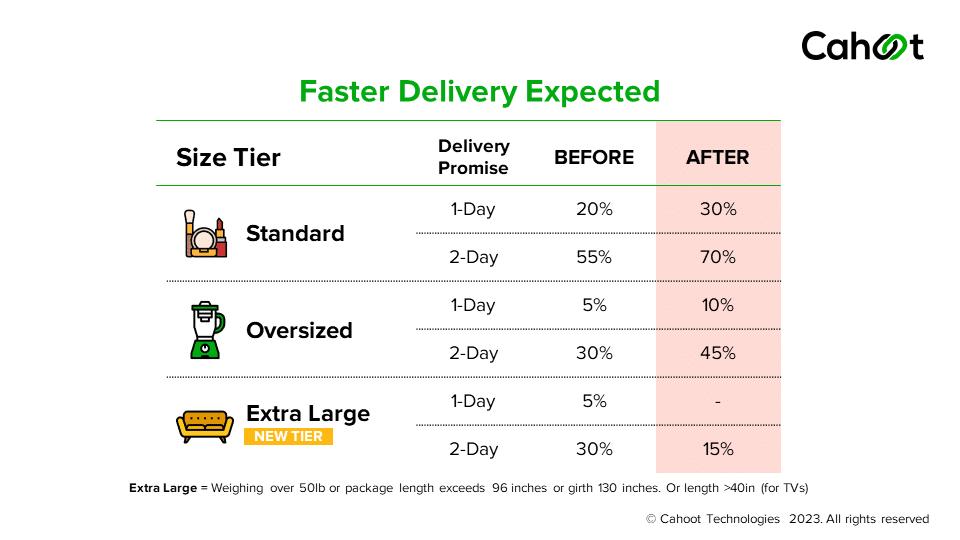
In its latest round of revisions to the program criteria, Amazon has increased the percentage of product detail page views that must promise 1 calendar day and 2 calendar day delivery. Thirty-percent (30%) of product detail page views for standard sized products must promise 1-day delivery, while 70% must promise 2-day delivery. But when does your listing promise 1-day delivery, and when does it promise 2-day delivery? Let’s understand this with a few examples:
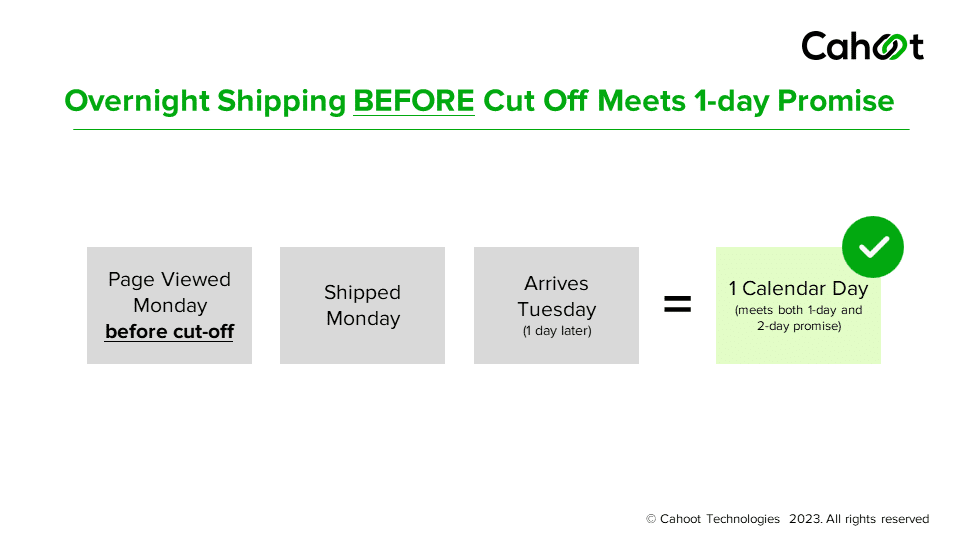
Let’s imagine every order is delivered the very next day after it ships. If a customer views your order on a Monday and places their order before the cutoff time, you will ship it that same day, and it reaches the customer the next day. In this case, Amazon displays a 1-day delivery promise and this page view counts towards your 1-day metrics.

In this second case, when a customer looks at the product detail page after the cutoff time, you ship the order the next day after it is placed, and it reaches the customer the following day. This therefore fails to meet the 1-day promise, but meets the 2-day delivery promise (which means that if a 2-day promise was made after Monday’s order cutoff time, one-day shipping still needs to be used to deliver it in 2 calendar days).

In this last case, it gets really bad. If a customer views your listing on a Saturday evening, the item is expected to ship on Monday (assuming you don’t ship Sundays) and it will be delivered to them on Tuesday – a full 3 days later.
In this case, such a page view counts toward neither the 1-day nor 2-day metrics. The implication is clear – your listings will display 2-day and even 3-day delivery promises for significant periods of time. The mapping between the number of warehouses you have, the percentage of the US population you can service with 1-day delivery, and the % page views that actually promise 1-day delivery is not linear. This graphic illustrates that:
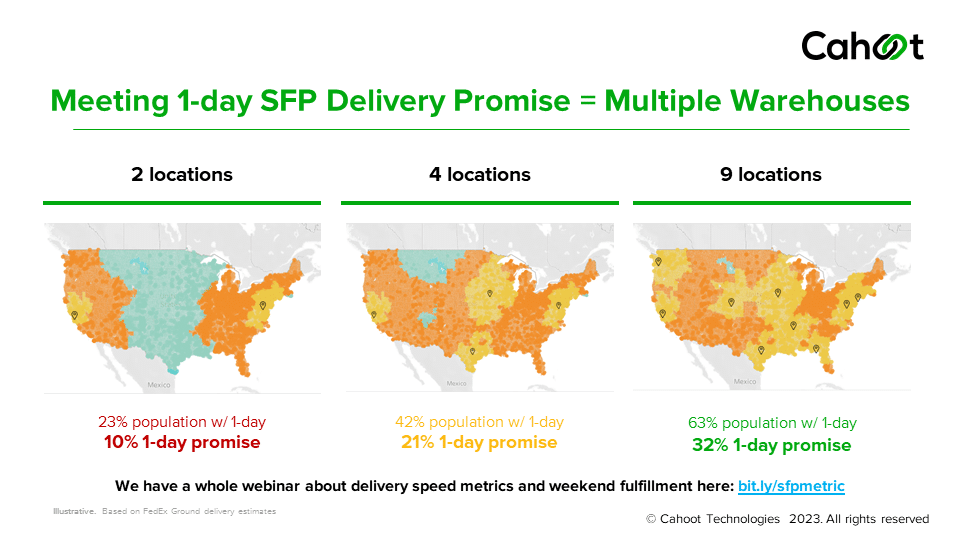
If you have warehouse locations, you can cover 42% of the US population with 1-day delivery. But different customers look at your product detail pages at different times of the day, and see different delivery speed promises. As per our research, in reality, only 21% of page views may actually promise 1 calendar day delivery. To meet the new Seller Fulfilled Prime delivery requirements, it could take as many as six to nine strategically located warehouses. These demanding metrics mean that traditional 3PLs will find it nearly impossible to help Seller Fulfilled Prime merchants (learn more about why traditional 3PLs are failing, and how peer-to-peer order fulfillment networks are designed to help you find success on SFP here). It becomes crucial for merchants to partner with order fulfillment networks that have warehouses at different strategic locations across the country, ensuring customers from anywhere see fast delivery promises. While merchants may want to upgrade to a fulfillment partner who is better positioned to meet these requirements, it’s easier said than done to leave your current 3PL for better alternatives. Many merchants don’t know how to evaluate and find the perfect fulfillment partner for them. If you’re looking for a step-by-step guide on migrating fulfillment partners, check out our guide here!
The Juggling Act Between Cut-off Times, Economical Shipping, and Meeting SLAs
With Seller Fulfilled Prime, a late cut-off time can potentially increase the number of orders your carrier picks up the same day, boosting your 1 and 2-day delivery metrics. If FBA faces any issues or does not meet the delivery promise shown to the customer on the product listing, there are no penalties for Amazon – but a Seller must meet the 93.5% on-time delivery criteria. Here’s a graphic demonstrating how delivery timelines look like when operating with a 2 PM cutoff time (based on our discussion of the page views metric):
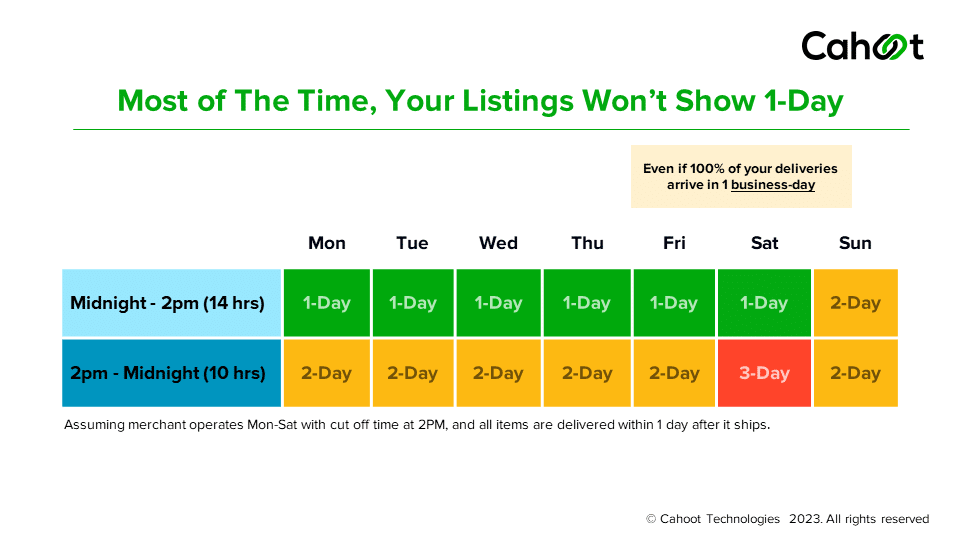
Sellers must carefully make the tradeoff between increasing their cutoff times (if they can schedule a late pickup with their carriers) versus also ensuring that those orders reach the customer the next day. Increasing the cutoff times increases the percentage of page views that promise 1 and 2-day delivery, but you must ensure that you can actually get the product to the customer’s doorstep within the time you’re promising. Here also, Sellers need to strategically place their inventory in a network of warehouses to avoid shipping orders placed close to cut-off times through expensive overnight air shipments. Placing inventory in different strategically located warehouses will enable nationwide coverage through economical ground shipping, all while meeting the customer’s expectations. Pay attention to time zones. A 2PM cutoff time is specific to the local time zone, so an order received before 5PM Eastern Time may need to ship from a western time zone to deliver on time, depending on the delivery promise. This makes it essential that your promotional activities (advertising, marketing) also closely follows the local time zones of the eyeballs you’re trying to reach. But it’s all very doable and Cahoot offers SFP consulting services to help. Reach out if you’d like to talk.
The shift to calendar days has had the most significant impact on the operational side of things – Sellers now have to plan a whole different way of running their business and schedules, which have also become challenges:
Operational Excellence Needed
Challenging to Staff And Operate Warehouses on Weekends
As we’ve mentioned before, staffing is often the biggest bottleneck towards finding success with order fulfillment. With weekend pick up and delivery expected to meet the calendar day-based SLAs, most merchants with a single warehouse or those working with 3PLs face difficulties succeeding in the program. If you own and operate your warehouses, paying your staff to work on the weekends or hiring additional people may eat into your margins to unfeasible extents. Traditional 3PLs, which are asset-heavy, also face cost pressures around labor – which they may be forced to pass onto Sellers. While these options erode any cost savings that Sellers see over FBA, you are not without alternatives – consider platforms like Cahoot, where each of our fulfillment centers is vetted for operational excellence and meets all the challenging requirements.
Arranging for Carrier Pickups on Weekends

In addition to warehousing, your carriers are another critical element in making your logistics work. Not all carriers offer weekend pick up and delivery – some may require you to be a large shipper and maintain minimum order volumes. All this means you may have to contact your account manager at the various carriers and enquire about possible options that may incur additional fees. However, while all this can be done, the biggest reason Sellers shy away from SFP is the heavy amount of process management, collaboration, and busy work needed to keep this operation running.
Managing Weekend Operations Can Overwhelm Sellers
It becomes easier to understand why so many Sellers shy away from Seller Fulfilled Prime – between working with multiple 3PLs to ensure your inventory covers the country, to operating and staffing your warehouses on the weekend as well as coordinating with your shipping carriers to arrange for weekend pickups, it can seem incredibly overwhelming and drain your bandwidth, time, and resources. You might often wonder whether managing so many stakeholders and sifting through so much busy work is worth it when FBA offers you only one party to work with – even if that party is Amazon, whose interests often tend to be misaligned with yours. It does not have to be this way – Sellers must spend time identifying partners who provide a unified experience where they get to work with just one vendor. Platforms like Cahoot help Sellers meet and exceed the SFP program requirement while ensuring you deal with only one company rather than coordinating between multiple 3PLs and carriers, preserving precious time and resources for you and your business.
Unnecessary Surcharges From Amazon Buy Shipping
In its latest round of revisions, Amazon no longer mandates the use of its Buy Shipping platform to print shipping labels. This is a major relief for Sellers, because Amazon Buy Shipping comes with one major issue that they have reported anecdotally – the platform is not great at estimating the delivery timelines for USPS services (the comment below from Amazon’s Seller Central forums highlights the issue):

In many situations, Buy Shipping does not accurately estimate the delivery timeline within which a USPS service can make orders. In such cases, Sellers are faced with a choice to pick from two bad alternatives: fail to show the customer a fast delivery promise (not an option for SFP Sellers) or buy a more expensive label from the choices that Buy Shipping does believe are capable of meeting the SLA:

This can be tough for Sellers to swallow – as order volumes increase, the extra costs paid on each shipping label begin to mount, eroding margins and profitability. Thankfully, Amazon no longer requires the mandatory use of the service. However, this does not automatically mean that you will see increased savings. You still need to make sure that you’re picking the most economical label on every order! This requires technology like Cahoot’s next generation shipping software, which intelligently rate shops across all carriers and shipping services from all available warehouse locations to always print the cheapest label that will meet the delivery date promised to the customer.
So while a lot can potentially go wrong, Sellers can also make the program work for them and find success by following specific, vital strategies. Start finding success in the SFP program by using the tricks and recommendations in our SFP Cheat Sheet!
“Cahoot is a game-changer. Their fully automatic shipping label creation intelligently assigns the best carrier and shipping service for all my orders across all my channels.”
~ LoveOurPrices.com
Speak to a fulfillment expert
The Cheat Sheet for Winning at Seller Fulfilled Prime
To enable Prime shipping, sellers must adjust their shipping templates and make specific selections in Seller Central and add all the warehouse addresses orders will ship from to support delivery regions for Prime service.
- Achieve Nationwide Coverage With a Warehouse Network: Making orders nationwide in under two days is no easy task. You need to distribute inventory strategically in at least 6 different locations to cover 97%+ of the country in this window. Operating from a single warehouse or one or two 3PL fulfillment centers will simply not cut it – you need to distribute your products across a network to meet the program requirements economically.
- Use Data to Guide Inventory Placement And Avoid Air Shipping: Even with a network model, it is crucial to analyze where most of your orders are coming from – placing your inventory close to those “order hubs” becomes a vital part of ensuring you will meet and exceed the one and two-day delivery requirements. This also ensures that you can reach all of your customers through economical ground shipping rather than being forced to make too many expensive air shipments.
- Consolidate Relationships And Eliminate Busywork: SFP can lead you down the rabbit hole of investing in multiple 3PLs and coordinating with numerous carriers to make the program work for you. Sellers need to conduct research and identify a platform that provides a single relationship for you to manage – otherwise, logistics can overtake your focus on the activities that matter – selling and taking care of your customers.
- Save Every Dollar Across Every Shipment: The whole point of moving away from FBA towards a program like SFP is to extract cost savings. It is essential to align your technology towards automation, whereby you’re automatically generating the lowest price shipping labels on every single order.
- Monitor Metrics Like a Hawk: Amazon provides you with dashboards on Seller Central that provide all the SFP metrics needed. It is crucial to constantly stay on top of these and keep adjusting your strategy to ensure you’re meeting expectations.
- Appeals Process: You get 14 calendar days from notice to file, 4 days to respond to Amazon’s follow-up, and are limited to 3 appeals per quarter (successful appeals don’t count against your quota). Each appeal must include order IDs, scans, zip codes, and proof of any carrier delays.
Succeeding in this program is challenging, but we think these tips are a great place to start. As Q4 and the holiday season approach, now is the time for Sellers looking to diversify their order fulfillment beyond FBA and offer fast, profitable free shipping across every SKU to identify a partner who can help you win at Amazon Seller Fulfilled Prime. If you’d like to understand how Cahoot can be with you every step of the way, just fill out this form, and we’ll be in touch!
Frequently Asked Questions
What is Seller Fulfilled Prime on Amazon?
Seller Fulfilled Prime allows you to list your products as Prime-eligible and handle the fulfillment yourself.
What is the difference between seller-fulfilled and Amazon fulfilled?
Logistics. Within the framework of Fulfillment by Amazon (FBA), the platform handles the entire logistics process – from product storage in warehouses to dispatching. Seller Fulfilled Prime (SFP) leaves you 100% in charge of everything in this regard, yet forces you to cover dispatch fees at your own cost.
How do you pre qualify for the Seller Fulfilled Prime trial?
To pre-qualify for the Seller Fulfilled Prime trial you must meet the following criteria over the past 90 days: Self-fulfilled at least 100 packages, Cancellation rate less than 2.5%, Valid tracking rate greater than 95%.
What is the difference between SFP and FBA?
FBA offers scalability and customer trust but comes with higher costs and limited control. FBM provides cost savings and customization options but requires more time and effort. SFP combines Prime eligibility with control over costs but has stricter requirements and operational challenges.
Is Seller Fulfilled Prime worth it?
In reality, it’s more of a trade-off. Seller fulfilled Prime offers the advantage of the Prime Badge and lower fees than FBA, but Amazon also levies stricter, potentially more costly requirements than FBM. But SFP orders can command higher prices (15 – 20%) and allow for more control. With a well-managed program, it can be quite beneficial.

Turn Returns Into New Revenue

Related Blog Posts
Seller Fulfilled Prime (SFP) & Premium Shipping Requirements Are Changing June 29, 2025: A Side-by-Side Deep Dive
In this article
 7 minutes
7 minutes
- Trial Enrollment & Graduation Windows for Seller Fulfilled Prime
- Monthly Volume & Enrollment Requirements
- Size-Tier Misclassification & Network Disruptions
- Appeals Process Overhaul
- OTDR Protection via Amazon-Managed Shipping Tools
- Premium Shipping Changes
- Putting It All Together: A Seller’s Checklist
- Final Thoughts
Starting June 29, 2025, Amazon is rolling out tighter performance guardrails for two of its marquee shipping programs: Seller Fulfilled Prime (SFP) and Premium Shipping. Seller Fulfilled Prime work refers to the process by which eligible third-party Sellers can fulfill Prime orders directly from their own warehouses, provided they meet Amazon’s strict performance requirements. For Sellers, these changes aren’t mere tweaks; they reshape how you qualify, stay in, and recover from hiccups in these programs. Below, we’ll walk through each key requirement as it stands today versus what you’ll need to hit after the effective date, with real-world examples to illustrate exactly what’s at stake. For a rundown of all program requirements, see the full Seller Fulfilled Prime Program and Premium Shipping policies.
Trial Enrollment & Graduation Windows for Seller Fulfilled Prime
Today:
- You can request a 30-day SFP trial any time.
- The SFP trial period lasts for 30 days and includes specific performance metrics that must be achieved to qualify for official enrollment in the program.
- Graduation from trial depends solely on meeting performance metrics during those 30 days.
After June 29:
- Three Trials Max per Year: You’ll be capped at 3 trial attempts in each calendar year. Any trial that begins before June 29, 2025 doesn’t count toward this limit.
- Quiet Periods Around Major Events: If your 30-day trial spans the 30 days leading up to Prime Days, Black Friday through Christmas, etc., you cannot graduate. This ensures Sellers are battle-tested before the busiest season.
Sellers must successfully complete the trial period by meeting specific performance requirements to gain access to Prime branding.
Why This Matters: Imagine you enroll in an SFP trial mid-October, aiming to graduate in time for Black Friday. Under the new rule, even flawless performance won’t earn you Prime status, you’ll have to re-enroll after the holidays. Plan your trials for quieter times (e.g., late January) to avoid losing a precious attempt.
Monthly Volume & Enrollment Requirements
Today:
- There’s no fixed minimum monthly SFP volume.
- If you miss on-time metrics, Amazon sends warning emails, but your enrollment status remains until metrics severely degrade.
After June 29:
- Minimum 100 SFP Shipments/Month: You must deliver at least 100 Prime-eligible packages each calendar month, spread reasonably across weeks, to maintain the Prime badge.
- Dynamic Order Limits: Fall below 100 (or cluster all shipments in one week), and Amazon will impose a reduced daily Prime order limit until you return to consistent volume.
- Exemption for Fix-Ups: If you get a second warning for missing any metric, you can pause Prime (no shipments) for a week to get your house in order, and that period won’t count against your enrollment.
Practical Example: You shipped 15 Prime packages in the first 3 weeks of May, then scrambled to ship 90+ in the final week. In June, you’ll wake up to find your Prime orders capped at a fraction of normal volume. Better to target 25–30 SFP orders per week and build in some slack.
Size-Tier Misclassification & Network Disruptions
Today:
- Listing ASINs in the wrong size tier might trigger warning emails, but rarely leads to immediate suspension. Misclassification can also result in higher storage fees, impacting overall profitability.
- Late deliveries during huge storms or carrier outages may or may not be excluded automatically.
After June 29:
- Strict Misclassification Guardrails: Repeatedly offering a product under the wrong size-tier can lead to blocking of SFP offers or Prime status suspension/revocation for those ASINs.
- Automatic OTDR Exclusions for Major Disruptions: Clearer language confirms that any late deliveries from Amazon-identified large-scale carrier or weather events are excluded from your OTDR automatically.
Scenario: You classify a product as having larger dimensions to qualify for the less strict performance requirements that apply to a larger size tier. After three such mistakes, Amazon silently blocks Prime on that ASIN. You’ll need to correct the tier and appeal to restore it—costly downtime.
Appeals Process Overhaul
Today:
- You have a sliding window to dispute removals, but timelines and submission limits are vague.
After June 29:
- 14-Day Filing Window: From the date you receive a notice (e.g., “Your SFP status is paused due to low OTDR”), you have 14 calendar days to open an appeal.
- 4-Day Response to Requests: If Amazon asks for more details, you have 4 days to reply, or your appeal is closed.
- Limit of 3 Appeals/Quarter: You can file up to 3 appeals per quarter (overturned appeals don’t count). Appeals require supporting data (order IDs, tracking numbers, ZIP codes, proof of carrier delays).
Why It’s Tougher: Say your OTDR dips because a regional carrier hub froze over two days. You’ll need to create a case including tracking scans, carrier advisories, and order logs quickly, or forfeit that appeal.
OTDR Protection via Amazon-Managed Shipping Tools
Today:
- If you use Amazon Buy Shipping and meet delivery cut-offs, late deliveries often still count against you unless you separately request exclusions.
After June 29:
- “OTDR Protected” Labels: If you enable Shipping Settings Automation in your Prime templates and purchase “OTDR Protected” labels through Amazon Buy Shipping, any late deliveries on Standard (for SFP) or Premium shipping won’t hurt your OTDR.
- Continued Exclusion of Major Disruptions: Same carve-out for large-scale network events.
Bottom Line: Automate shipping profiles and purchase labels using Buy Shipping API, and you effectively get “insurance” against minor late-delivery slips.
Premium Shipping Changes
Amazon’s Premium Shipping program (items promised in 1–3 business days) gets its own tightening:
|
Requirement
|
Today
|
After June 29
|
|---|---|---|
|
OTDR Threshold
|
97%
|
93.5%
|
|
Measurement Window
|
Rolling 30-day period
|
Weekly (Sun–Sat)
|
|
Enforcement Steps
|
Removal upon sustained dip
|
3-strike system:
1st miss – warning email 2nd miss – warning email 3rd miss in 4 consecutive weeks – removal |
|
Warning Reset
|
None
|
4 consecutive perfect weeks clears prior infraction
|
Key Impact: Under the new cadence, a single bad week can put you on notice, and three such weeks in a month spells immediate removal from Premium Shipping. You’ll need more consistent performance throughout each month, not just a healthy 30-day aggregate. Sellers must successfully complete the new performance metrics to maintain their status in the Premium Shipping program.
Putting It All Together: A Seller’s Checklist
- Schedule Your SFP Trial Smartly: Avoid major sale seasons; plan for Q1.
- Lock Down 100+ Prime Shipments/Month: Automate your SFP orders to spread volume evenly across weeks.
- Clean Up Your ASIN Tiering: Audit listings for correct size tiers and package profiles.
- Enable Shipping Automation + Protected Labels: In Seller Central > Fulfillment Settings, turn on SFP/Premium templates and default to OTDR-protected labels.
- Monitor Weekly OTDR: Invest in an operations dashboard that can track your OTDR by week for both SFP and Premium orders.
- Prepare an Appeals Kit: Create a template for submitting an appeal with sections for order logs, tracking scans, and carrier advisories so you can file within 14 days. Cases created after 14 calendar days will not be considered.
- Build in Buffer for Disruptions: If a regional snowstorm hits, pre-notify Amazon to be considered for exemption from performance defects proactively. Consider outsourcing your SFP fulfillment to a distributed fulfillment network that organically solves for carrier network disruptions and ensures the highest performance metrics for continued program eligibility and enrollment.
- Understand SFP Program Requirements: Familiarize yourself with the stringent requirements of the SFP program and adapt to changing Amazon policies to maintain your SFP status.
Final Thoughts
These new Seller Fulfilled Prime (SFP) and Premium Shipping requirements underscore Amazon’s push for ultra-reliable, ultra-consistent delivery, a win for customers, and a heavier lift for Sellers. But by meeting these new standards, (whether independently or with the help of a distributed fulfillment network), Sellers can maintain access to Prime branding and the substantial customer base of Amazon Prime members, mitigating the risk to the sales opportunities afforded by the Amazon Seller Fulfilled Prime Program.
By understanding the before-and-after, planning trial timing, automating wherever possible (especially Prime shipping options), and building a rapid-response appeals process, you can not only stay enrolled in SFP and Premium Shipping programs but thrive in them.
Watch the Video

Turn Returns Into New Revenue

Related Blog Posts
Shopify vs Amazon: Why Brands Lose and How to Fight Back
In this article
 17 minutes
17 minutes
Cahoot’s exclusive study with Forbes shows that many of the most successful DTC brands on Shopify let Amazon and Walmart beat them on price and delivery experience for their own products.
Companies like L’Occitane have spent millions upon millions building their sterling brands in an attempt to win and retain loyal customers. Their Shopify-powered webstores offer top-notch purchasing experiences. Their marketing is dedicated to building an image that will stand the test of time. Yet their product is more expensive and ships slower on their own store than it is on Amazon:
With this price and shipping disparity, it’s unlikely that a comparison shopper would choose to buy from L’Occitane’s site. When you factor in that over half of all eCommerce searches start on Amazon, you’d better believe that Amazon is eating significantly into DTC stores’ growth.
This is no small challenge – Amazon takes a 15% referral fee on most categories, and every search on Amazon of course serves up multiple competitive options to the buyer. So not only is L’Occitane earning much less profit on each sale they do get on Amazon, but they’re also losing customers. The problem persists even when it’s 3rd party sellers listing the product on Amazon – they buy at wholesale prices, which cuts into L’Occitane’s margin compared to purchases from the DTC store. And of course, the Amazon listing pulls shoppers away from L’Occitane’s site, making it more difficult to build customer loyalty.
We don’t mean to pick on L’Occitane. In fact, Cahoot demonstrated that among a sample of popular products from 50 top Shopify brands that sell on both their own store and Amazon, Amazon is cheaper and offers faster delivery 49% of the time. When you look at the all-in price for a quickly shipped product, Amazon beats the brands in all cases but one.
In this guide, we’ll dive deep into how brands can manage competition between their DTC stores and marketplaces. First, we’ll establish the stakes – why does this matter, and how much does it cost brands? Then, we’ll dive into the data itself and a case study to bring the challenge to life. Finally, and most importantly, we’ll provide a primer on how brands can fight back to boost their critical DTC channel’s growth.
What Brands Lose When a Marketplace Sells Their Product
A sale is a sale, right?
Wrong – selling direct-to-consumer (DTC) online is much more lucrative for a brand than selling on a marketplace like Amazon.
Here are four reasons you need to maximize the number of customers you convert on your DTC store and keep them away from marketplaces.
Profit Margin
First and foremost, selling on marketplaces incurs a hefty referral fee that of course doesn’t exist on a seller’s DTC site.
Amazon’s fee ranges from 8% all the way up to 45%, but the most common percentage it takes is 15%. What is your current margin on your top seller? 15% off the top line could cut your take-home profit in half, or worse.
And keep in mind that Amazon isn’t just taking 15% off of the item price – they add up extra fees and charges to calculate “Total sales price” before calculating their referral fee. Consider this example from Amazon Seller Central below:
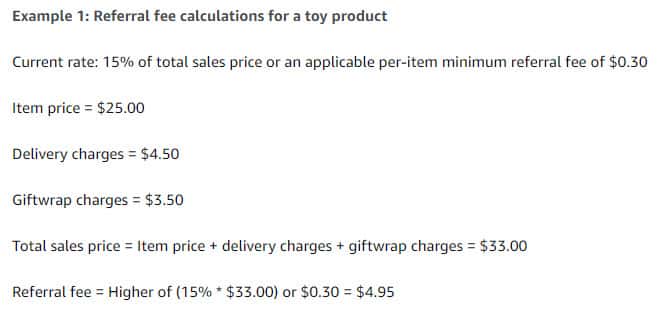
The “15%” referral fee of $4.95 actually is almost 25% of the item’s $25 price tag, because Amazon adds additional fees before calculating their final take. So, if the seller’s margin was a strong 35% before the fee, it’s cut all the way down to 10%.
This issue persists even if it’s a 3rd party reselling the product on a marketplace, and not the brand itself managing the listing. The reason is simple – the reseller buys the product either at a wholesale price or at a retail discount, and then re-lists on the marketplace. So, the per-unit margin is still lower for the brand.
If you’re wondering how these fees compare to those on Shopify, check out this comprehensive review article on Shopify Plans & Pricing from our friends at Rush.
Increased Competition
The margin challenge is the most obvious and pressing, but it often doesn’t even come into play. If a shopper browses a marketplace, they’re served many competitive options and may not buy the original brand’s product in the first place.
Brands may not even realize this is happening, but it’s ubiquitous – a full nine out of ten online shoppers comparison shop between DTC web stores and marketplaces. Every time a shopper checks prices on a marketplace, they’re not just comparing the original brand’s product on the DTC store to the brand’s product on the marketplace. They’re also offered pages upon pages of competitive products, putting the sale at risk.
What starts as a simple price check instead increases competitive pressure. If the original brand still converts the sale on the marketplace, they do so at lower margin, but often they don’t even convert the sale, losing out entirely.
Lost Customer Data
One of the most valuable pieces of a sale isn’t the money, but the customer’s email. Without customer data, you can’t target them with marketing, and you can’t build loyalty. And that loyalty is incredibly valuable – the Harvard Business Review reports that just a 5% increase in customer retention rates increases profits by 25% to 95%. Not to mention, acquiring a new customer costs five to twenty-five times as much as retaining an existing one.
Shopify provides sellers with a detailed break-down of how to maximize customer lifetime value, and it suggests simple yet effective tools such as a customer loyalty program.
If your prospective customer buys your product on a marketplace instead of your webstore, you won’t get the chance to include them in value-maximizing programs like a loyalty program, and you’ll have to spend marketing dollars to try to acquire them all over again. Considering that a “good” LTV/CAC ratio is 3:1 in eCommerce, that means you’ll have to spend a third of the total potential value of that customer a second time, erasing a huge amount of the profit you could have earned.
No Chance to Upsell or Cross Sell
Top eCommerce platforms like Shopify and BigCommerce offer many apps to upsell or cross sell a customer to increase order value and thus profit. You have a much stronger opportunity to get more out of every visitor to your store than you do to get the most out of someone who’s considering your product on a marketplace. Sure, Amazon has features like “People Also Bought”, but it isn’t limited to your products and thus can drag customers away from you just as readily as it can win a bigger purchase.
Contrast that with an app like Zipify’s One Click Upsell, available on Shopify. This and other apps create a custom upsell and/or cross sell experience for your web store, ensuring that it’s the best possible quality and in line with your strategic vision.
Each time your customer price checks your DTC store on a marketplace and finds a better offer there, you lose an opportunity to expand their cart with your products and maximize order value.
Lost Custom Unboxing Experience
Last but not least, orders fulfilled by marketplaces will ship in the marketplace’s boxes, so they reap the marketing rewards while the brand loses a chance to further cement customer loyalty.
Custom boxes drive value in a few key ways:
- Marketing on outside of the box
- Curated unboxing experience delights customers to increase repeat rate
- Customer unboxing testimonials are great for social selling
- Custom boxes can include inserts that reinforce upsell, cross sell, and brand loyalty initiatives
This key opportunity to create a customer for life is lost when Amazon gets the order.
The Data: Shopify vs Amazon & Walmart
Now that you understand what’s at stake, I’m sure you’re interested to know why exactly marketplaces win over DTC sites.
We compared the price of flagship products for 50 top Shopify brands on their own webstore to the price of the same exact products on Amazon and Walmart. The degree to which Amazon and Walmart have superior offers surprised us.
Our methodology was simple – we searched Shopify stores and marketplaces for identical products from the list of top Shopify brands, and when both the DTC store and a marketplace had an identical product, we made a direct comparison. Not all brands had products listed on marketplaces – of the 50, 29 had identical products listed on Amazon, and 24 had identical products listed on Walmart.
Right off the bat, the marketplaces offer better prices for identical products most of the time. When you look at the final sale price, which includes the cost of the cheapest possible shipping option, 59% of the Shopify stores we researched have worse prices for identical goods than Amazon. 58% have worse prices than Walmart. It’s not a small gap, either – in each comparison, the DTC store is over 25% more expensive than the marketplace.
It would be bad enough if the gap ended there, but it doesn’t. In addition to costing more, the Shopify web stores also often ship those identical products more slowly than the marketplaces. In this comparison, the marketplace matters – Amazon’s famed Prime program helps it ship faster than most DTC stores. On the other hand, Walmart usually ships at the same speed as the DTC comparisons, or more slowly.
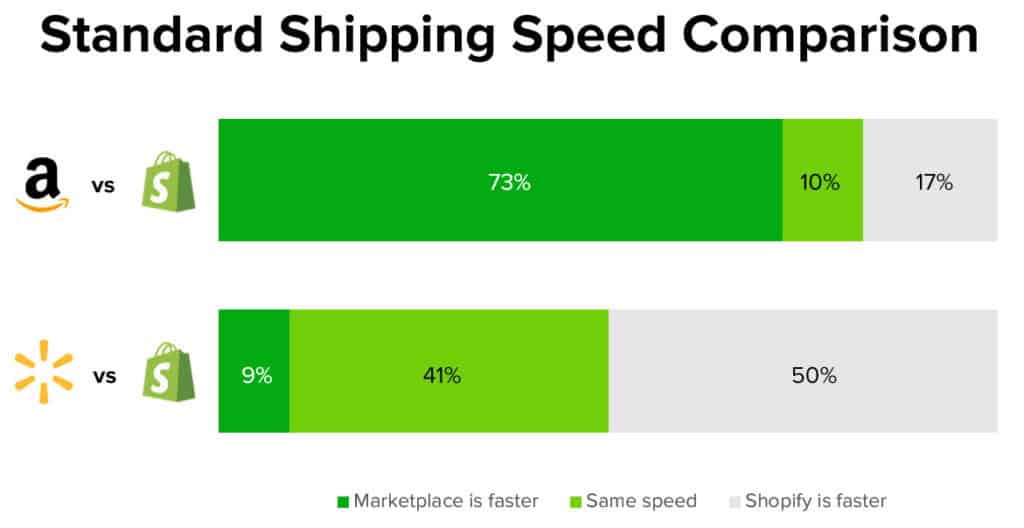
Source: Cahoot original research
On top of that, shipping is free for both marketplaces. The average shipping cost for the Shopify stores is a whopping $7.61.
Finally, let’s say that a customer needs a package shipped to them quickly. If they pick Amazon, of course they’ll get that order within two days for no extra cost thanks to Prime. If they need to pay for expedited shipping from a Shopify store, though, they’ll end up paying through the roof.
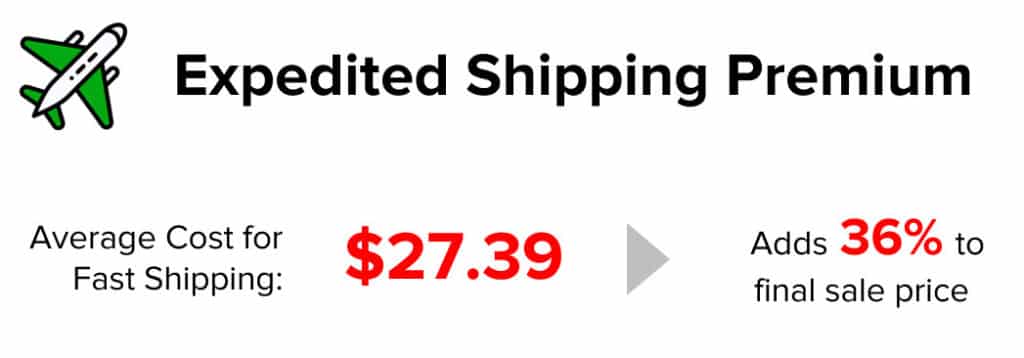
Source: Cahoot original research
The average cost of fast shipping for the products we evaluated was $27.39, and if selected, it added a whopping 36% to the final sales price.
Now, remember that nine out of ten online shoppers comparison shop between DTC web stores and Amazon. They pull up the identical product on the brand’s website and a marketplace, and they’re likely to find that the marketplace offers a cheaper product that will arrive more quickly. And that’s the reason brands lose out to marketplaces online.
Want to see the detailed view? We also have a store-by-store comparison of the Shopify price vs the Amazon price for identical products.
This first chart compares the total DTC website price to the Amazon price for identical products with standard shipping.
- Green bars show brands whose DTC store product price is less than 90% of Amazon’s price
- Yellow bars show brands with products between 90% – 110% of Amazon’s price
- Red bars show brands that have products in their DTC store that are more than 110% of Amazon’s price
You already know the outcome, but it’s striking to see the detail. Only a few brands can beat Amazon’s price by 10% or better, while nearly half are more than 10% more expensive. And of course, they’re nearly all shipping more slowly than Amazon.
Next, we took a look at the same price comparison between Shopify store products and their listings on Amazon, but we set the shipping speed for both to “fast”.
Only a single brand, Morphe, offers a better price than Amazon while shipping in 1-3 days. Two more, Rhone and Leesa, are within 10% of Amazon’s price. Every single other brand is more than 10% more expensive than Amazon, and many are over 50% more expensive!
There’s simply no comparison here – Amazon decisively wins on critical aspects of eCommerce.
Case Study: L’Occitane
L’Occitane offers an excellent example of the benefits and challenges of selling on a DTC website. Founded in 1976 by Olivier Baussan, it was named for the women of Occitania – a region that existed in the Middle Ages in the south of France and whose language still survives today.
They have a beautiful website built with Shopify, and in fact it’s doing quite well – their online sales grew 69.2% YoY for the fiscal year ending in March ‘21, and they compensated for most, but not all of physical sales lost from stores closed due to COVID.
While strong, their results could be even better. Indeed, we like this case study because it underscores that even strong online sellers fall prey to marketplaces.
If Amazon and Walmart weren’t undercutting them on price and beating them on shipping speed, could online sales growth have completely offset store sales declines?
Benefits of Selling on a Shopify Site
L’Occitane’s success online is no mystery – they do most things right.
Right off the bat, they provide an appealing offer in exchange for a visitor’s email address. Think back to the huge value of repeat customers – they know that the single most important thing that they can do is get an email so that they can build loyalty.

image courtesy: loccitane.com, 12/6/21
They build on this with an excellent home page that ticks off many best practices for webstore design. Their hero steers customers towards what they’re most likely looking for (in this case, holiday gifts). They have value-added visuals that help the visitor envision the products and what they’ll be buying. Last but not least, they have the all-important “Cookie bar” at the bottom of the page, which prompts the visitor to accept tracking cookies.
Thanks to changes in web privacy laws, sites now have to ask for opt-ins for users to allow their behavior on the site to be tracked by a cookie. You might be surprised by how often this works; one study in Europe, which implemented the practice before America, found that 95% of users express consent, versus just 5% who refuse cookies. Together with an email address, this enables L’Occitane to follow up with the visitor and build customer lifetime value.
L’Occitane also aggressively pursues upsells and cross sells with special offers.
The above offers are a perfect case study in upsell and cross sell. On the left, the “Little Wonders” kit induces customers to increase the size of their cart in exchange for a “free” gift. On the right, the “Holiday Shea Butter Duo Set” encourages customers to buy an extra product along with their existing cart.
Amidst these best practices, though, lies one glaring fault: shoppers can get a better deal for L’Occitane products on marketplaces. As we noted before, nine out of ten online shoppers check DTC store prices on marketplaces before they buy. So before the email capture and before the upsell, customers will see that they can save money and get the product faster by buying elsewhere. How many online shoppers does L’Occitane lose to this very dynamic?
How Amazon and Walmart Still Win
It’s simple – marketplaces beat L’Occitane on price and shipping.
We’ve checked L’Occitane’s offer for its 8.4 Oz Verbena Body Lotion consistently over 2H 2021 against the same product listing on Walmart and Amazon, and it consistently falls short.
Up front, L’Occitane’s list price of $29.50 matches that of Amazon, while it trails Walmart’s $55.50 for a 2-pack (or $27.75 each). That doesn’t seem so bad on the surface – after all, it matches Amazon’s price and is only beaten by Walmart’s price because Walmart is offering a volume discount.
Move on to checkout, though, and things change. On loccitane.com, the shopper is hit by a whopping $4.95 shipping fee, while of course on Walmart and Amazon shipping is free. So L’Occitane’s Shopify store price is 16% higher than Amazon’s.
Adding onto the price woes, shipping is also faster on the marketplaces than it is on L’Occitane’s site. L’Occitane offers standard shipping, with delivery estimates usually between 5-8 days. Walmart’s shipping estimates three-day delivery, while Amazon Prime promises next-day delivery. If you’re a loyal customer, and you want it faster from L’Occitane’s site, you’ll have to pay a huge $27.99 for expedited 2-3 day shipping. So, you can nearly double the price of the item, and it will still show up slower than Amazon’s free shipping.
Better price, faster shipping – how many customers have made this exact same calculation and bounced away from L’Occitane’s site in favor of a marketplace?
How Brands Can Fight Back
Brands can’t keep up because for them, fast shipping means expensive shipping.
The only way a merchant can affordably power fast shipping for their products is to adopt a distributed fulfillment model, like that of Amazon. Their famed distribution network now has close to 100 locations across the United States, and they strategically place inventory in multiple locations across the country. No matter where a customer is, Amazon has the product nearby.
Historically, merchants simply haven’t been able to adopt Amazon-like distributed fulfillment short of using Fulfilled by Amazon. If a merchant wants to do it themselves, then they need 4-5 locations to cover the whole country with 2-day shipping, and 10+ for 1-day shipping. That’s out of reach for all but the largest enterprises – and even large merchants are struggling to find warehouse space and labor to power their delivery networks today.
On the other hand, most 3PLs weren’t designed with eCommerce in mind, and so they struggle to provide affordable fast shipping for their clients. 66% of 3PLs in the United States have fewer than 3 warehouses, which isn’t enough even for 2-day shipping. So if a merchant signs up with one 3PL, they’ll have to expedite orders to cover the country with fast shipping. Alternatively, they might sign up with multiple 3PLs and try to stitch them together with complex OMS integrations. This overhead-intensive solution puts a band-aid on the issue, and it comes with high complexity, high failure rates, and high costs.
To level the playing field with Amazon, merchants need a modern fulfillment network that was designed for the rigors of fast & free eCommerce. The best modern networks will have 10 or more locations across the country, user-friendly software, native integrations with major eCommerce platforms and marketplaces, and more. They’ve been designed purposefully to power merchants’ growth with affordable fast shipping across all channels.
If you’d like to learn more about what to look for in a fulfillment provider, here’s a primer on how to choose the right 3PL for your Shopify store. And when you’re ready to evaluate competitors, here’s a 3PL RFP template that will help you make the right choice.
Cahoot’s fulfillment network is built for eCommerce. We’ll level the playing field with Amazon with affordable 1- and 2-day shipping – right on your DTC store.
Our innovative peer-to-peer model offers low-cost, fast fulfillment by design. We’re changing the industry by empowering merchants with excess warehouse space and resources to provide high-quality order fulfillment to other merchants. As a result, our pricing is typically lower than that of other top providers listed above, but we can beat them on fulfillment speed and reliability. If you’d like to find out how Cahoot can help your business, please get in touch with us. We can’t wait for you to join our community and fight back against the big marketplaces.

Turn Returns Into New Revenue

Amazon FBA Peak Season Fees: A Deep Dive
In this article
 3 minutes
3 minutes
Amazon’s FBA peak season fees have become a significant factor for sellers operating on the platform. With fulfillment fees increasing by 6% and storage fees nearly tripling during peak periods, it’s essential to understand the implications and explore alternative strategies.
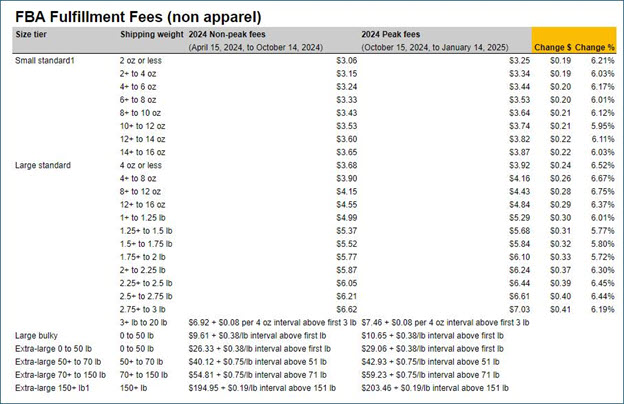
A Historical Perspective
Peak season fees on Amazon have been a recurring phenomenon for several years. As the platform’s popularity has grown, so has the demand for its fulfillment services. To accommodate the increased volume of orders, Amazon has implemented peak surcharges to offset the additional costs associated with hiring seasonal workers, expanding warehouse capacity, and optimizing logistics.
Comparing to Competitors
While Amazon’s peak season fees might seem steep, comparing them to other e-commerce marketplace platforms is worth it. Walmart Fulfillment Services, for instance, also increased its storage fees during peak periods but did not raise fulfillment fees. This suggests that Amazon is more aggressive in passing the costs to sellers.
Peak Season Surcharges
Given Amazon’s reliance on seasonal workers to handle the peak demand, peak season surcharges will likely continue for the foreseeable future. As long as the platform experiences significant growth during holiday periods, Amazon must ensure it can efficiently fulfill orders.
Strategies for Managing Peak Season Fees
While peak season fees can be a challenge for sellers, there are several strategies to mitigate their impact:
- Optimize Inventory Levels: Carefully forecast demand and adjust inventory levels accordingly. Overstocking can lead to higher storage fees, while understocking may result in lost sales.
- Consider Alternative Fulfillment Options: Explore options like Seller Fulfilled Prime (SFP) or outsourcing to third-party logistics (3PL) providers. SFP allows you to fulfill orders yourself while offering Prime benefits to customers. 3PL providers can often offer competitive rates and flexible solutions, especially during peak seasons.
- Negotiate with Amazon: If you have a significant sales volume on Amazon (8 figures or more), consider negotiating with the platform to secure more favorable terms or discounts.
- Diversify Sales Channels: Reducing your reliance on Amazon can help mitigate the impact of its peak season fees. Explore other sales channels, such as your website or marketplaces like eBay.
- Offer Promotions and Discounts: Encourage early purchases by offering promotions or discounts during non-peak periods. This can help reduce the inventory you need to store during peak season.
The Role of 3PL Providers
Third-party logistics providers can be valuable for sellers looking to reduce peak season fees. By outsourcing fulfillment to SFP-ready 3PL providers like Cahoot, you can offer free, fast delivery of your products on Amazon and other channels while avoiding additional peak season surcharges. 3PL providers can also help with inventory management, order fulfillment, and returns processing.
Conclusion
Amazon’s peak season fees are a reality that sellers must navigate. By understanding the factors driving these fees and implementing effective strategies, you can minimize their impact on your business. Whether you choose to optimize your inventory, explore alternative fulfillment options, or negotiate with Amazon, it’s essential to proactively address these challenges and ensure your long-term success on the platform.

Turn Returns Into New Revenue

Amazon Pulls the Plug on Thousands of Vendors
In this article
 2 minutes
2 minutes
Receive a big check every month for selling your products directly to Amazon wholesale? Get ready to change the way you do business with the e-commerce behemoth. If you own a small business that currently moves less than $10 million in sales volume through Amazon, or Amazon has not paired your company with an assigned vendor manager, the company will now require you to sell your products through its third-party marketplace by default.
Receive a big check every month for selling your products directly to Amazon wholesale? Get ready to change the way you do business with the e-commerce behemoth. If you own a small business that currently moves less than $10 million in sales volume through Amazon, or Amazon has not paired your company with an assigned vendor manager, the company will now require you to sell your products through its third-party marketplace by default.
Moving smaller vendors to its third-party platform allows Amazon to eliminate costs associated with directly supporting smaller companies that bring in less revenue. Once a business is on the third-party platform, Amazon also has the ability to charge for additional services, such as Fulfilled by Amazon and account management.
Amazon’s first-party business will focus on maintaining relationships with high value brands and companies involved in the production of Amazon’s private-label products.
The change is expected prove difficult for smaller, first-party vendors that lack the existing systems and infrastructure to support competitive third-party marketplace sales and distribution.

Turn Returns Into New Revenue

Tariff Shock 2025: Understanding the Tariff Shopper’s Mindset
In this article
 9 minutes
9 minutes
The 2025 tariff increases have intensified economic pressures on ecommerce sellers, leading to heightened anxiety over rising Costs of Goods Sold (COGS) and the potential loss of customers and revenue due to necessary price adjustments. Meanwhile, consumers are also compelled to adapt swiftly, and sellers must take the time to understand the psychological shifts in consumer spending and implement strategic business adjustments to sustain and grow their businesses in these turbulent times.
The Psychology of the Tariff-Era Consumer
Economic uncertainty, amplified by the recent tariffs, has significantly influenced consumer behavior. Shoppers are exhibiting increased caution, prioritizing essential goods over discretionary spending. This shift is rooted in the desire to maximize value and ensure financial stability amid rising prices. For instance, consumers are stocking up on non-perishable items like canned goods and household supplies in anticipation of further price hikes.
Buyer Personas in the 2025 Tariff Environment
1. The Budget-Conscious Parent
- Goals: Stretch the household budget to cover essential needs for the family.
- Purchases: Bulk buys of diapers, generic brand groceries, and discounted children’s clothing.
- Product Positioning: Emphasize “Bulk Savings,” “Family Essentials,” and “Value Packs.”
2. The Small Indulgence Shopper
- Goals: Seek affordable luxuries to maintain morale without a significant financial impact.
- Purchases: Artisanal chocolates, scented candles, and specialty teas.
- Product Positioning: Highlight “Affordable Luxury,” “Treat Yourself,” and “Everyday Indulgence.”
3. The Prepper-Inspired Planner
- Goals: Prepare for potential shortages and future price increases by stockpiling essentials.
- Purchases: Emergency food kits, multipurpose tools, and first-aid supplies.
- Product Positioning: Use “Be Prepared,” “Emergency Essentials,” and “Long-Term Value.”
4. The Homebody Investor
- Goals: Enhance the home environment to compensate for reduced spending on external entertainment.
- Purchases: Home improvement tools, board games, and home workout equipment.
- Product Positioning: Focus on “Home Comforts,” “Staycation Upgrades,” and “Invest in Your Space.”
Product Categories Resilient to Tariff Impacts
1. Made-in-USA Goods
- Examples: Handcrafted furniture, domestically produced apparel, and local artisanal foods.
- Rationale: Avoidance of import tariffs makes these products more competitively priced.
- Consumer Appeal: Patriotic support for local businesses and assurance of quality.
2. Luxury and High-End Items
- Examples: Designer handbags, premium electronics, and high-end kitchen appliances.
- Rationale: Affluent consumers may remain less sensitive to price increases, sustaining demand.
- Consumer Appeal: Perceived long-term value and status associated with luxury goods.
3. Essential Goods
- Examples: Toiletries, over-the-counter medications, and staple food items like rice and bread.
- Rationale: Necessities maintain consistent demand regardless of economic conditions.
- Consumer Appeal: Indispensable nature ensures prioritized spending.
4. Sustainable and Eco-Friendly Products
- Examples: Reusable water bottles, biodegradable packaging, and solar-powered gadgets.
- Rationale: Growing environmental consciousness drives demand, and domestic production may mitigate tariff effects.
- Consumer Appeal: Alignment with personal values and potential long-term cost savings.
5. Digital Goods and Services
- Examples: Online streaming subscriptions, e-books, and virtual fitness classes.
- Rationale: Intangible products are not subject to import tariffs.
- Consumer Appeal: Immediate access and convenience.
Products Likely to Experience Price Hikes
Certain products are more susceptible to price increases due to their reliance on imported materials or components. Consumers may consider purchasing these items before tariffs fully impact retail prices:
- Electronics: Smartphones, laptops, and televisions often rely on imported components, making them vulnerable to price increases.
- Automobiles and Parts: Vehicles and replacement parts are facing higher tariffs, leading to increased costs for consumers.
- Appliances: Refrigerators, washing machines, and microwaves may see price hikes due to increased costs of imported steel and components.
- Furniture: Items such as sofas and dining sets, especially those manufactured overseas, are likely to become more expensive.
- Footwear and Apparel: Clothing and shoes imported from tariff-affected countries may experience price increases.
Strategies for Ecommerce Sellers to Adapt and Sustain Their Businesses
In response to the tariff-induced economic shifts, ecommerce sellers can implement several strategies to maintain profitability and meet changing consumer needs:
1. Diversify Sourcing and Manufacturing
- Reshoring Production: Bringing manufacturing back to domestic facilities can mitigate tariff impacts and supply chain disruptions. While this transition requires significant investment and time, it offers long-term stability and control over production processes. However, it is important to note that reshoring efforts have historically faced challenges, including high domestic costs and infrastructure limitations. Analysts caution that without substantial policy support, significant reshoring remains unlikely.
- Nearshoring: Establishing manufacturing operations in neighboring countries with more favorable trade agreements can reduce tariff exposure and shorten supply chains. This approach balances cost-effectiveness with logistical advantages.
- Alternative International Suppliers: Identifying suppliers in countries less affected by the tariffs can help maintain competitive pricing. For instance, shifting sourcing from China to the Philippines or Malaysia may offer cost benefits. However, make sure to fully evaluate the reliability and quality standards of new suppliers.
2. Optimize Inventory Management
- Stockpiling: Increasing inventory levels of high-demand or tariff-impacted products can buffer against supply chain disruptions and price volatility. This strategy requires careful financial planning to manage the associated carrying costs.
- Just-in-Time (JIT) Inventory: Implementing JIT practices minimizes holding costs by aligning inventory levels closely with demand. While this reduces storage expenses, it necessitates a highly responsive supply chain to avoid stockouts.
3. Implement Strategic Pricing Adjustments
- Transparent Communication: Clearly informing customers about the reasons for price increases, such as tariff-induced costs, or how you’re making changes to improve efficiency so you can maintain pricing at this delicate time, can foster understanding and promote trust.
- Value-Based Pricing: Emphasizing the unique value propositions of products, such as superior quality or sustainability, can justify higher prices. Highlighting these aspects differentiates products in a competitive market.
- Bundling Products: Offering product bundles or value packs can enhance perceived value, encouraging customers to make purchases despite price increases. This strategy can also help move inventory more efficiently.
4. Enhance Supply Chain Resilience
- Supplier Diversification: Reducing dependence on a single supplier or region decreases vulnerability to disruptions. Building relationships with multiple suppliers ensures alternative options are available when needed.
- Supply Chain Visibility: Investing in technology that provides real-time tracking and analytics enhances the ability to anticipate and respond to potential issues promptly. Improved visibility aids in proactive decision-making.
- Collaborative Relationships: Strengthening partnerships with suppliers and logistics providers and collaborating on solutions to mitigate tariff impacts and streamline operations.
5. Leverage Technology and Automation
- Ecommerce Platforms: Utilizing advanced ecommerce platforms can optimize operations, from inventory management to customer relationship management, reducing overhead costs. Platforms like Cahoot offer technology-driven solutions to enhance efficiency.
- Automation Tools: Implementing automation in areas such as order processing and fulfillment can reduce labor costs and improve accuracy, contributing to overall cost savings.
- Outsourcing Fulfillment: Distributing inventory to support 1- and 2-day nationwide shipping using ground services lowers final-mile transportation costs while meeting customer delivery expectations. The improved margins often pay for the managed services.
6. Explore Alternative Product Offerings
- Domestic Products: Focusing on products manufactured domestically can circumvent tariffs and appeal to customers interested in supporting local businesses. This approach aligns with growing consumer preferences for locally sourced goods.
- Digital Products: Expanding into digital goods and services, which are not subject to import tariffs, can diversify revenue streams and reduce reliance on physical products.
7. Monitor and Advocate for Policy Developments
- Stay Informed: Keeping abreast of trade policies and tariff changes enables proactive adjustments to business strategies. Regularly consulting reliable news sources and industry reports is essential.
- Industry Advocacy: Participating in industry associations and advocacy groups can influence policy decisions and provide collective support in navigating trade challenges.
By implementing these strategies, ecommerce sellers can address the challenges posed by rising prices (COGS) due to the new reciprocal tariffs, maintain customer loyalty, and sustain revenue streams. Adaptability, informed decision-making, and strategic planning are crucial in turning these challenges into opportunities for growth and resilience.
Frequently Asked Questions
How are the 2025 tariffs impacting ecommerce consumer behavior?
The 2025 tariffs have caused a noticeable shift in consumer psychology. Shoppers are now prioritizing essential goods and cost-saving strategies while reducing discretionary spending. Many are stockpiling staples like canned food and household items in anticipation of future price increases, while others seek small indulgences or home improvements to maintain quality of life without overspending. Ecommerce sellers must understand these behavioral shifts to effectively reposition their offerings and messaging.
What types of products are most vulnerable to price hikes under the new tariffs?
Products that rely heavily on imported components or materials, such as electronics, appliances, automobiles and parts, furniture, and imported footwear or apparel, are particularly susceptible to price increases. Ecommerce merchants should anticipate rising COGS in these categories and consider both inventory planning and sourcing adjustments to stay competitive.
What can ecommerce sellers do to protect their margins and customer base amid rising COGS?
Sellers should take a multi-pronged approach:
- Diversify sourcing (e.g., explore nearshoring or alternative countries less affected by tariffs).
- Enhance inventory strategies, like stockpiling high-demand SKUs or implementing just-in-time models.
- Use value-based pricing and communicate price changes transparently.
- Introduce bundles and domestic alternatives to maintain customer loyalty.
- Leverage technology (like Cahoot’s advanced shipping and fulfillment platform) to reduce operating costs and improve delivery efficiency.
Why is reshoring or nearshoring worth considering despite the upfront costs?
Reshoring production or nearshoring to neighboring countries like Mexico can help ecommerce businesses mitigate future tariff risks, reduce lead times, and gain more control over their supply chains. While it involves higher initial investment, the long-term benefits include greater stability, increased brand trust from “Made in USA” labeling, and potential cost savings from improved logistics and reduced reliance on volatile overseas markets.
How can technology platforms like Cahoot help ecommerce sellers weather the tariff storm?
Cahoot goes beyond traditional shipping software by offering a peer-to-peer fulfillment network, multi-carrier rate shopping, predictive cartonization, hazmat compliance tools, and automated shipment monitoring—all designed to reduce shipping costs, improve fulfillment speed, and maintain customer satisfaction. These capabilities allow sellers to absorb rising COGS more effectively without compromising service quality or profitability.

Turn Returns Into New Revenue







